A premium product refreshed and ready to excel in the post-pandemic landscape
Airlines are struggling mightily to restore their operations on this side of COVID, but higher flying hasn’t been rendered impossible in the meantime. Delta, for example, has spent the better part of the pandemic refreshing its fleet of Boeing 767s, and as a result, boasts one of the more comfortable ways to travel long-haul on a U.S.-based carrier. These planes are 25 years old on average, but because of such comprehensive refurbishments in all classes of service, they feel much younger than they actually are. Newly installed lie-flat seats are the centerpieces of Delta One (i.e. its brand name for business class), and all come with direct aisle access, ample, private space to lounge around, and professional-looking design elements that still convey a sense of luxury. While its competitors have been catching up to Delta’s standing in the premium domestic market – and surpassing it in some regards – the carrier has no equal between New York and Hawaii.
All things considered, Delta’s premier experience is quite different now compared to how it was pre-COVID. In Winter 2022, the carrier overhauled its soft product to include more sustainable comforts; the iconic Tumi amenity kits and Westin Heavenly Bedding sets are out, and artisan-made pouches and recycled-plastic-bottles-turned-blankets are in. To the horrors of some higher flying winos, many bottles of red, white, and bubbly have been replaced by canned alternatives. Whether or not these changes are motivated by a sense of corporate responsibility or are merely thinly-veiled cost-cutting measures – some commentators are cynical – Delta One still remains one of the better ways to fly within the United States. In business class, no other domestic carrier can provide the same combination of lie-flat seats, direct aisle access for everyone, schedule convenience and network connectivity, and service(s) both in the air and on the ground. United comes close to matching, but Delta Medallion status holders are eligible for complimentary upgrades on such routes whereas United’s elite members are not (which could be a key difference for some). Moreover, assessing reputation is inherently flawed, but Delta consistently ranks among the top three U.S. airlines.
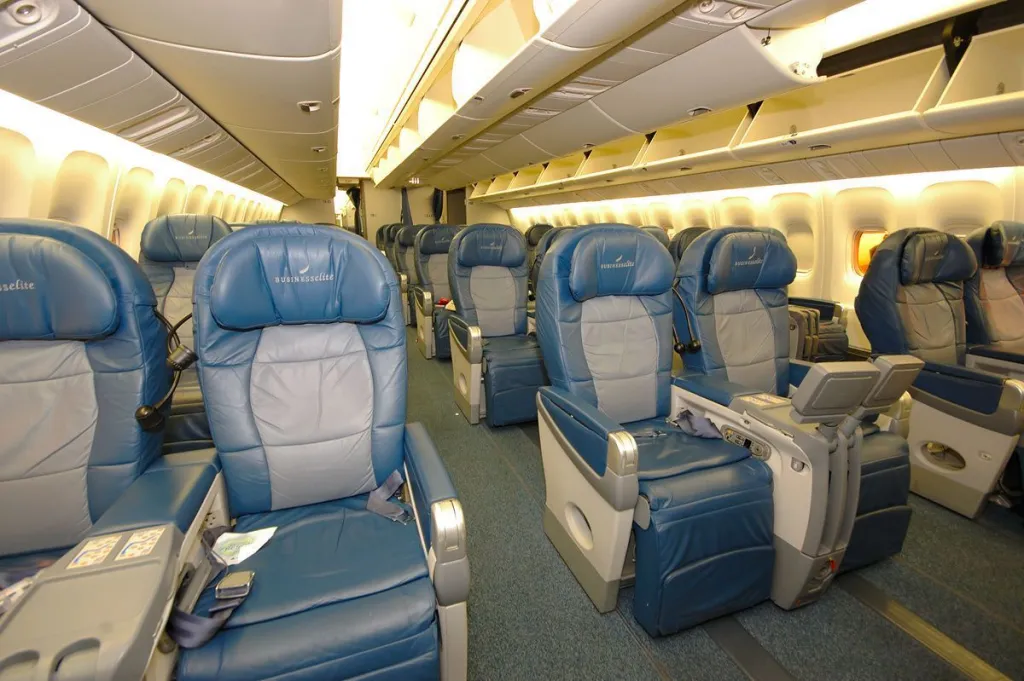
In February 2022, Delta announced plans to expand its Hawaiian presence, in part using its refurbished 767s to operate between New York and Honolulu beginning in November that year. This is the second longest domestic flight – second only to Hawaiian Air’s Honolulu-Boston route – with competition from Hawaiian and United, albeit with the latter based out of Newark. Now that the route is officially up and running, the cost of Delta One fares to and from Honolulu (as they are wont to be) can be reasonable while simultaenously maddening. The cash rate in a vacuum can often be a pretty good deal…
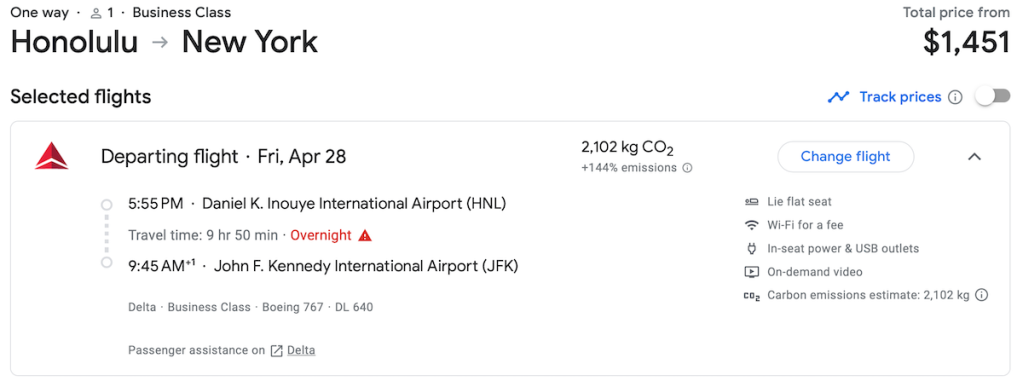
…But when you compare Delta’s price to its closest competition, it becomes exponentially more appealing.
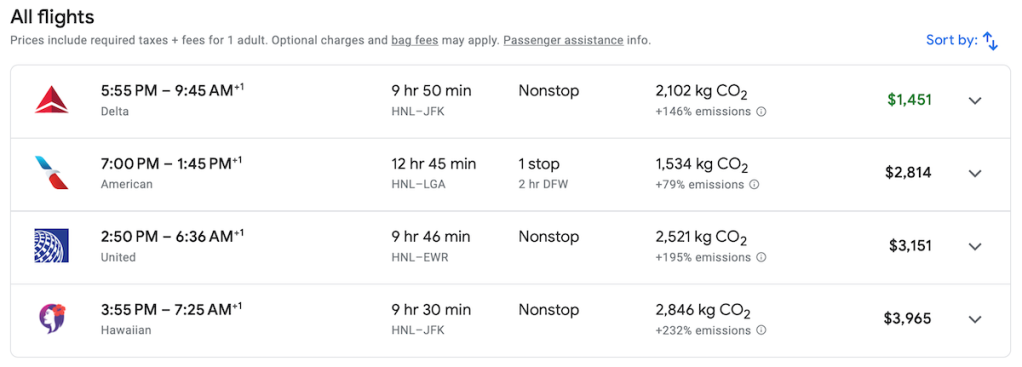
Related reading: “On perceiving ‘good’ value”
Heaven help you if you want to pay with points, for instance, unless you’re cool with dropping six figures worth of SkyMiles for a redemption valued at around 1.1 cents per mile. Partner availability is a rarity, too, but it’s not like any of this should come as a surprise; on its own metal, Delta really wants its customers to pay as close as possible to cash-points parity.

To Delta’s credit, economy fares are also affordable…
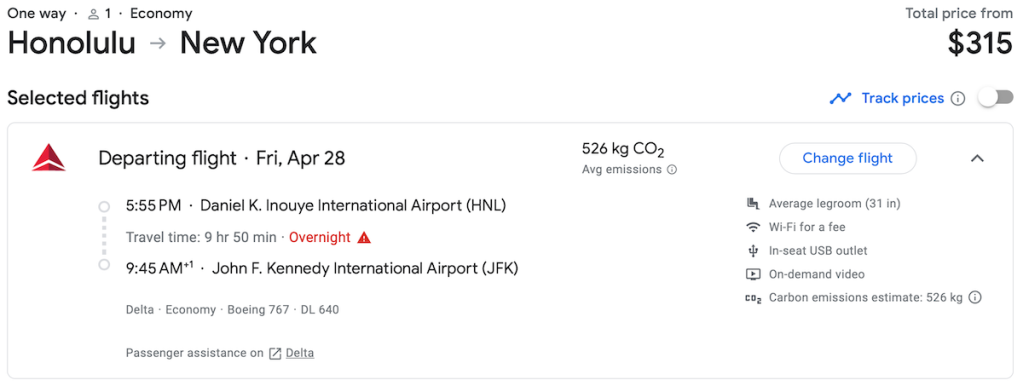
…And from there you can easily upgrade into Delta One, either by paying an upcharge sometime after booking – on my particular flight it cost $859 or 79,900 SkyMiles (a redemption also valued at 1.1 CPM) – or for free the day of departure, if you’re a Medallion status holder who’s comfortable waiting it out.
On the ground, Delta One passengers are granted access to priority check-in desks and security lanes, as well as a SkyClub lounge once airside. There’s a location in Honolulu famed for its creative cocktails, but alas, I was running late and had to scramble to catch the flight. The plane was fully loaded by the time I showed up, so while it’s not necessarily representative of typical boarding processes, this was the easiest part of my predeparture experience. The scene that awaited on the other end of the jetbridge was a happy one, with a crew of flight attendants joking and laughing before the door closed behind me.
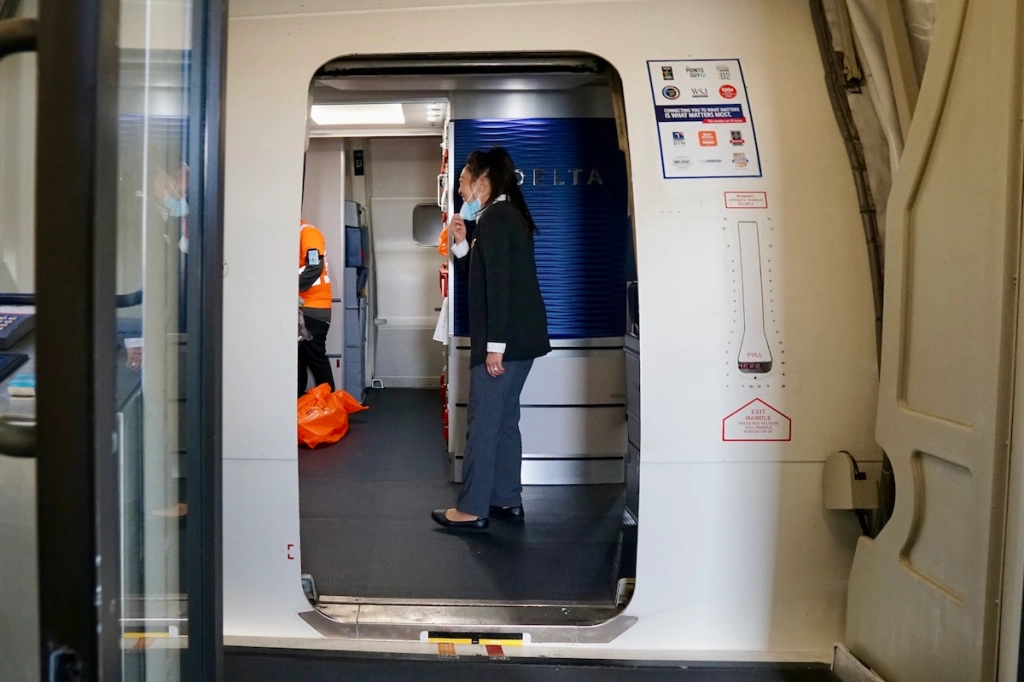
Delta Airlines DL 305
Honolulu (HNL) – New York-JFK (JFK)
Scheduled Departure: 16:55 (17:04 wheels up)
Scheduled Arrival: 7:30 + 1 day (7:06 wheels down)
Duration: 9:02
Aircraft: Boeing 767-400
Seat: 8D
After stepping onto a refurbished 767-400 and turning left, Delta One gives a strong first impression. The 34-seat cabin isn’t opulently luxurious in the way Qatar QSuites are, but it instead looks professional and befitting for a crowd of business travelers. For a plane that’s been flying since April 2000, this exceeds expectations – you can’t tell the bird is as old as it is – and it will likely remain in good shape for the next few years.
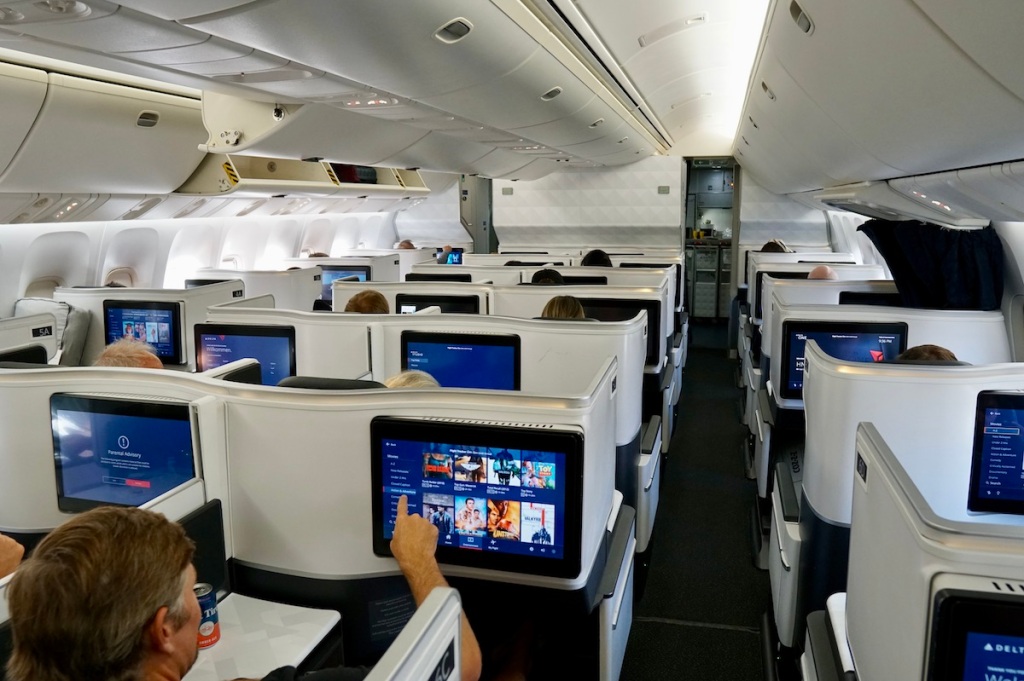
Delta has elected to install lie-flat seats in what’s known as a 1-2-1 staggered configuration. This means the cabin is laid out so that everyone has direct access to an aisle, but some are closer to it than others. This is particularly true for window seats; a passenger in an even row is up against the wall – with a side console serving as a buffer to the aisle – whereas someone in an odd row is closer to the aisle, with the console placed adjacent to the windows. To maximize space efficiency, your footrest is enclosed in the forward seat’s console.
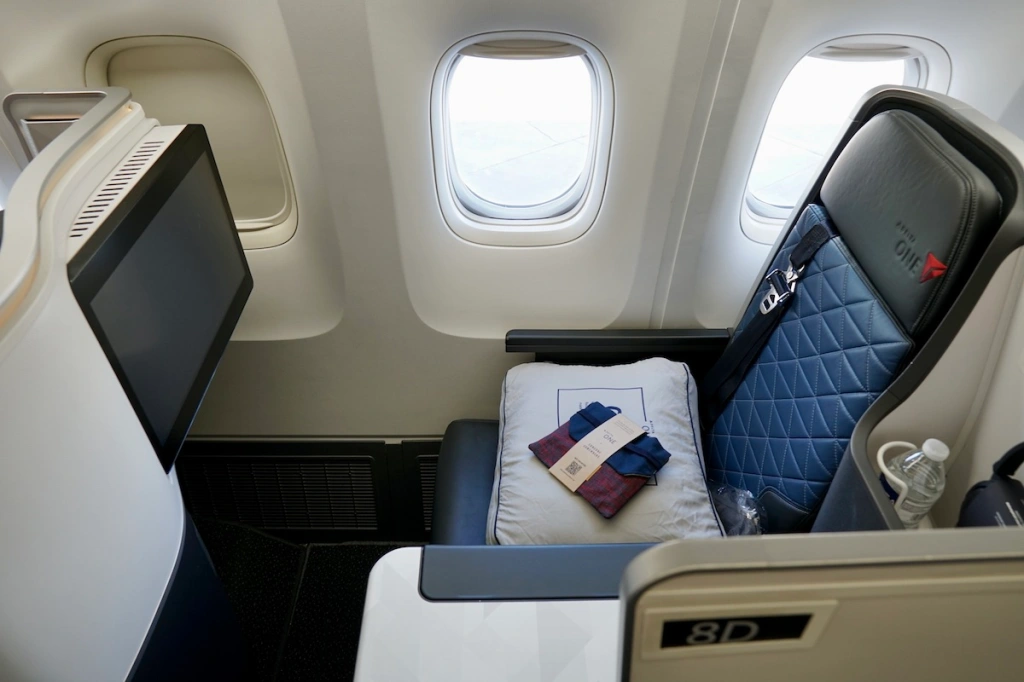
The “true window” seats are the most desirable in Delta One because they offer extra privacy and marginally better views, but otherwise, they’re designed near-identically (the staggers are nothing more than mirrors of each other) compared to the others and are effectively the same. So, unless you’re really into flightseeing, don’t worry if you can’t land an even row window – you’re still in for a treat!
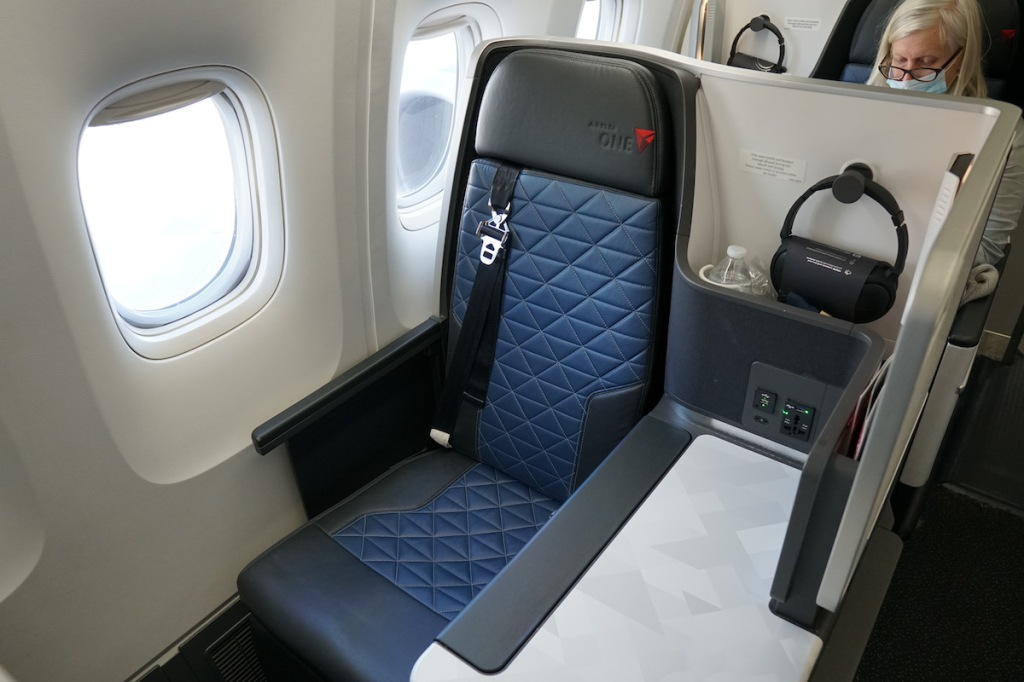
The majority of the seat’s features and controls are located on/near its side console. Don’t read this as a complaint, but most everything here, like the cabin as a whole, is tastefully utilitarian and clean-looking. It’s not exactly snazzy, but like a bowl of vanilla ice cream, it’s agreeably inoffensive and there’s not too much to complain about. Moreover, having such conveniently placed and functional power sources – ones capable of delivering electricity via an international outlet and/or a USB Type A jack – is an important but typically unheralded benefit.

Granted, there are a few interesting details, like a patterned countertop that looks kind of similar to marble (but won’t ever be mistaken for marble), an angular ambient light fixture, and elaborate stitches and embossments into the upholstery. Hard white (and gray) plastics otherwise dominate the scene, but there’s nothing wrong with that.
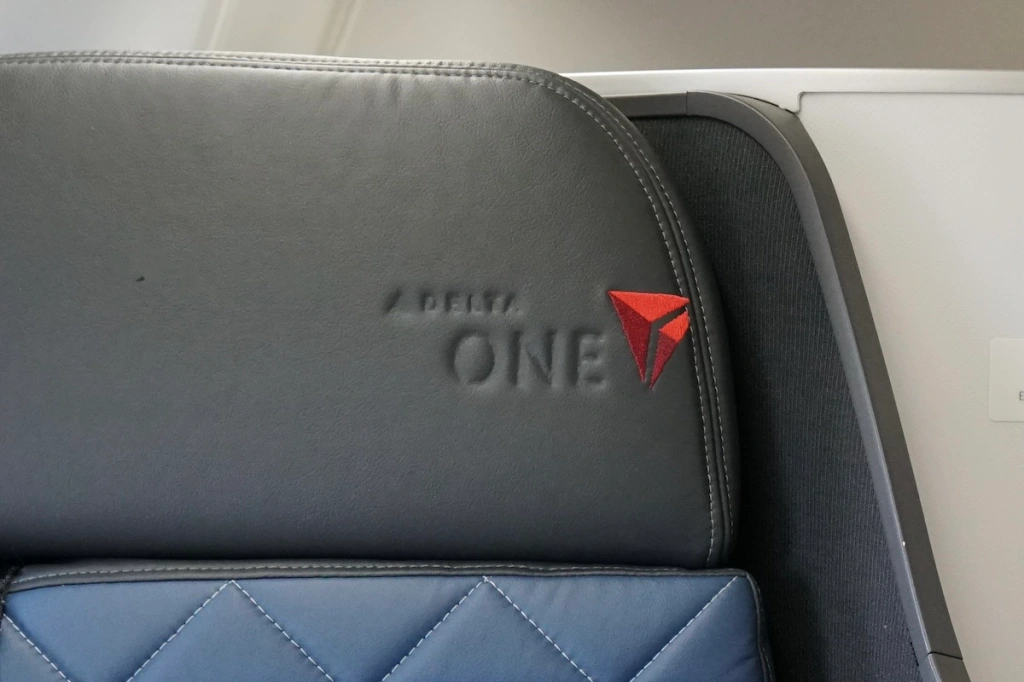
The side console is plenty large enough for you to keep belongings close by while in-flight, and should you need a container, there’s a slot wide and deep enough to store an iPad, a travel wallet, and/or other similarly-sized items without exposing them to passersby.
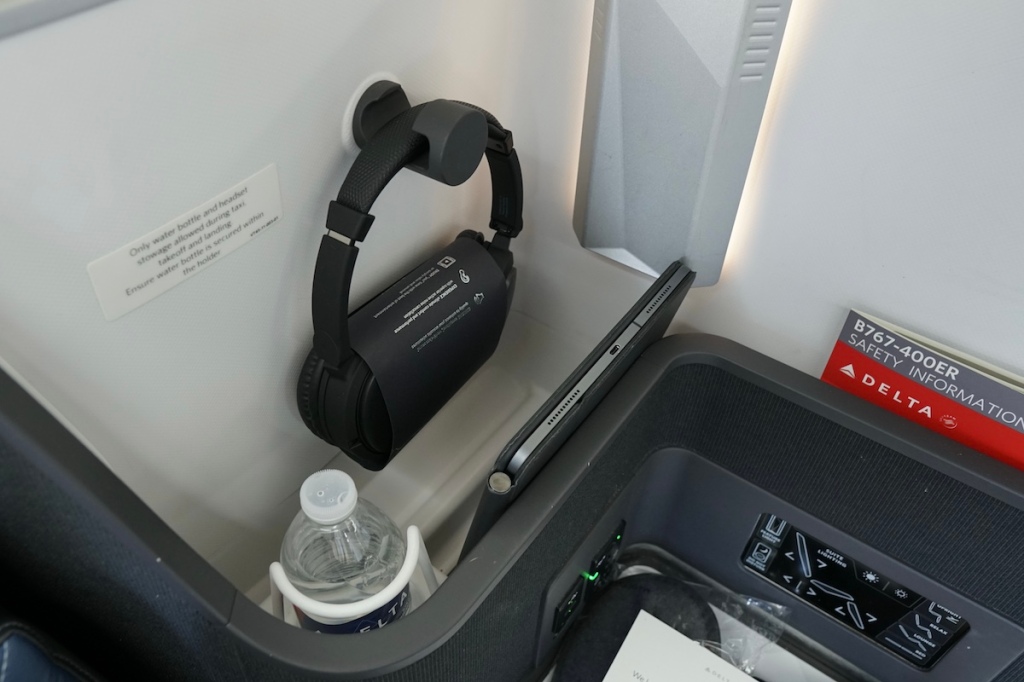
The tray table springs out diagonally from beneath the console’s top surface, and it’s worth noting that while you can’t get out from the seat when it’s deployed, it’s easily maneuverable, spacious, and sturdy enough to support a laptop. The tables built into past iterations of 767 Delta One seats have been far more complicated to operate and far less flexible – this is a welcome improvement on the refurbished plane.
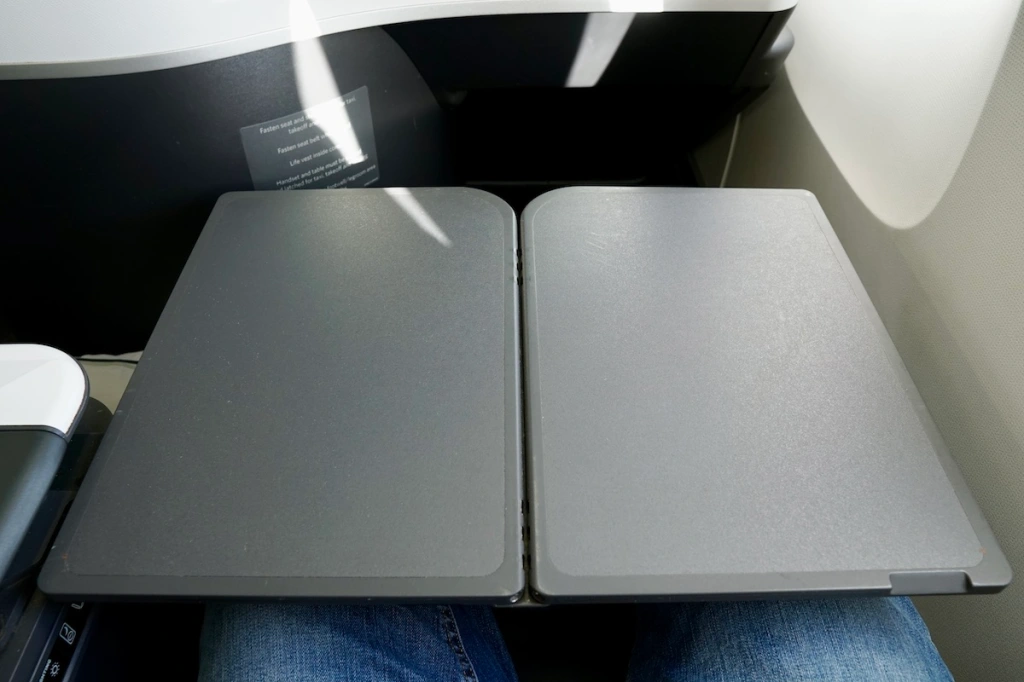
A pleather-clad armrest flips up to reveal a remote for the in-flight entertainment system – which is nice to have but only so useful when there’s a responsive touchscreen monitor – and a small vanity mirror, which is a thoughtful inclusion. Want to make sure you don’t have food stuck in your teeth or apply a quick layer of make up before landing? You’re all set.
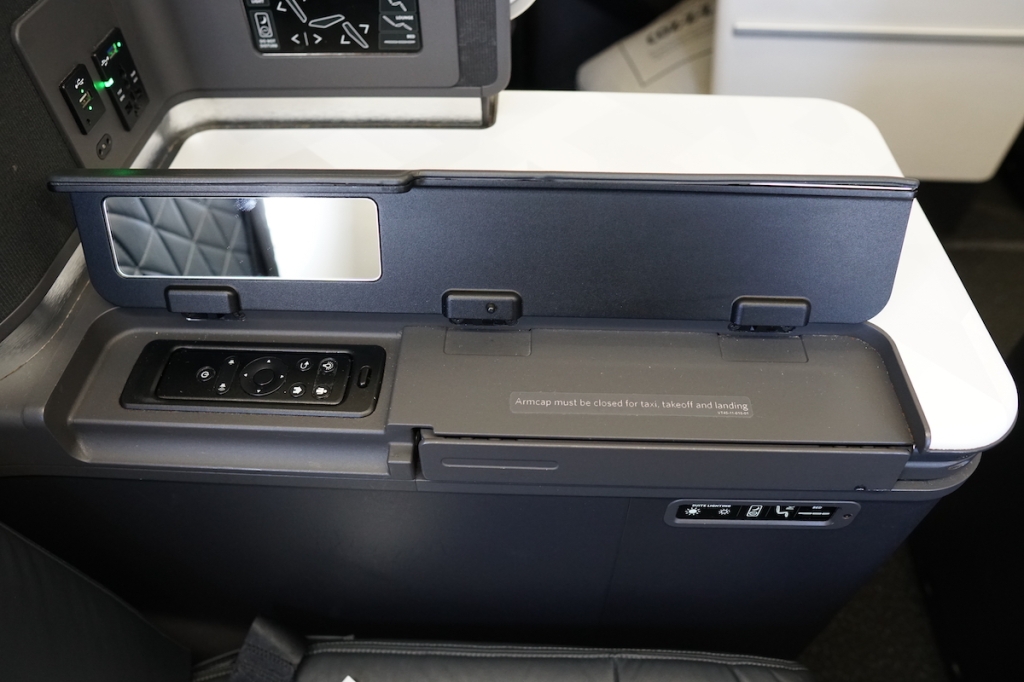
To adjust your seat, convert it into a bed, and then turn the lights off (and do the reverse when it’s time to wake up), there are touch capacitive buttons located on both the suite’s “wall” and just above the seat cushion. The latter is particularly useful, as it allows you to tweak your position and/or lighting situation while you’re fully reclined, but both struggled to consistently register inputs.
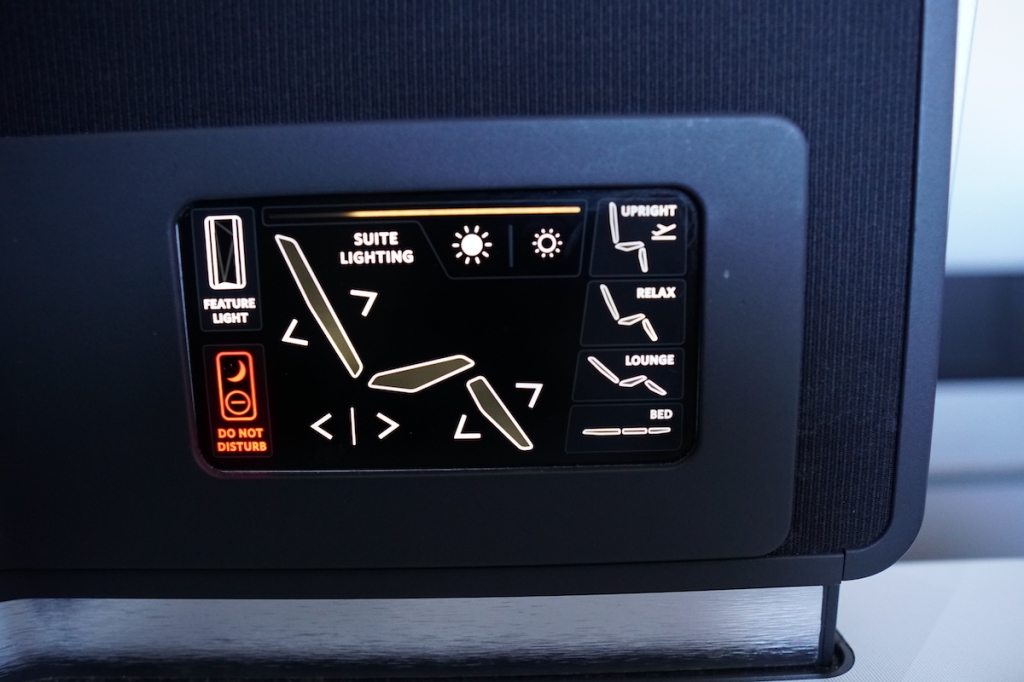
Individual air vents seem to be growing increasingly rare – good luck finding them in foreign carriers’ premium cabins – but Delta fortunately bucks this trend on its 767-400s. These are perhaps the most underrated seat controls, as they allow travelers to perfect their sleeping conditions as best they can. My sunburned skin appreciated the cool airflow!
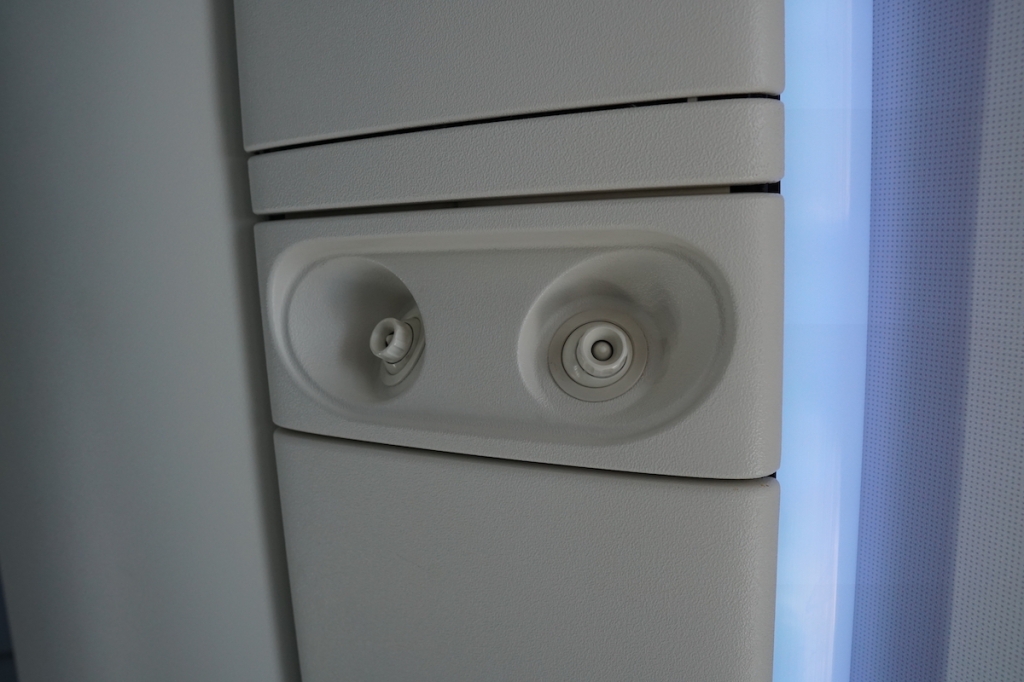
Consistent with the surrounding interior design, the seat’s forward portion is simple: there’s a broad white panel that contrasts dramatically with the huge, black 18-inch in-flight entertainment system.
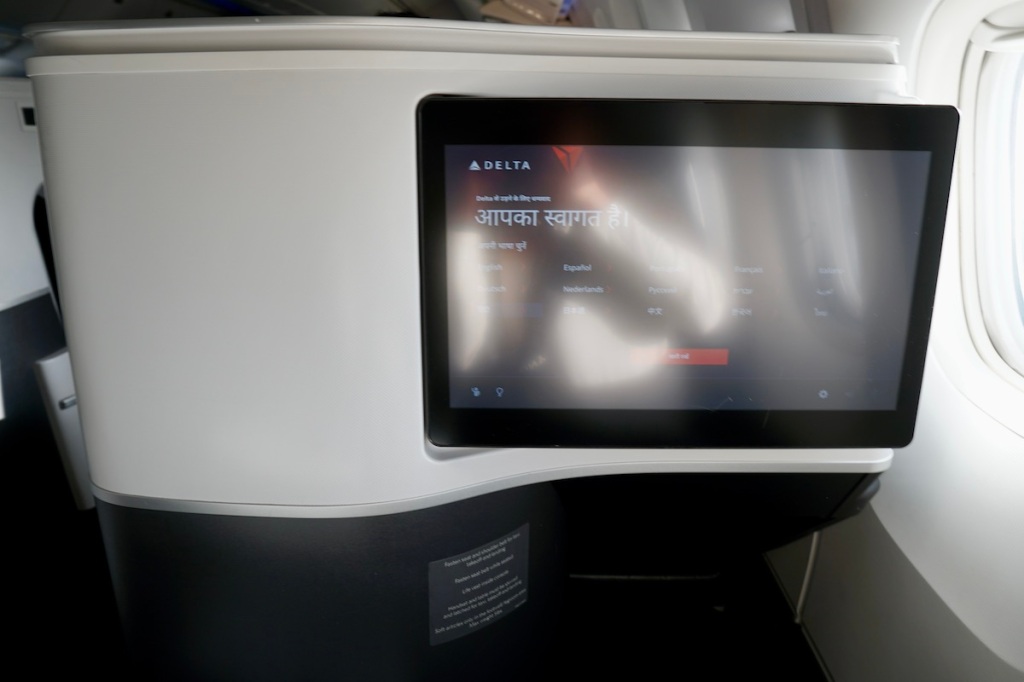
There’s a sloping footrest underneath the monitor, which can help make lounging around all the more comfortable, and then a cubby (underneath the forward seat’s side console) that extends the length of the sleeping surface area once the chair reclines into a bed.
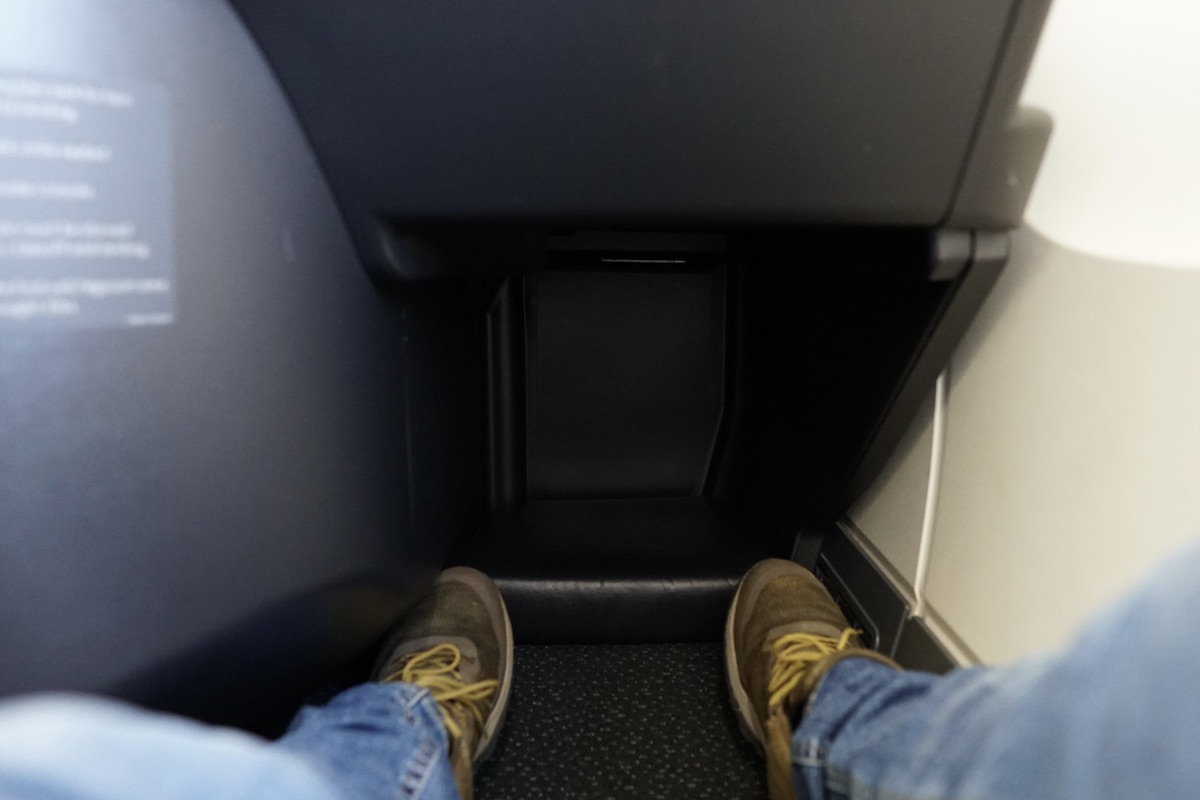
Delta doesn’t cut corners with its in-flight entertainment, licensing hundreds of movies (546 on this particular plane), dozens of episodes from 41 TV shows (including “prestige” channels like HBO and Showtime), and 123 albums, among other things. Everything is presented on a responsive 18-inch, high definition touchscreen monitor. Frequent flying IFE connoisseurs might disagree, but it’s hard to imagine running out of consumable content onboard a Delta plane.
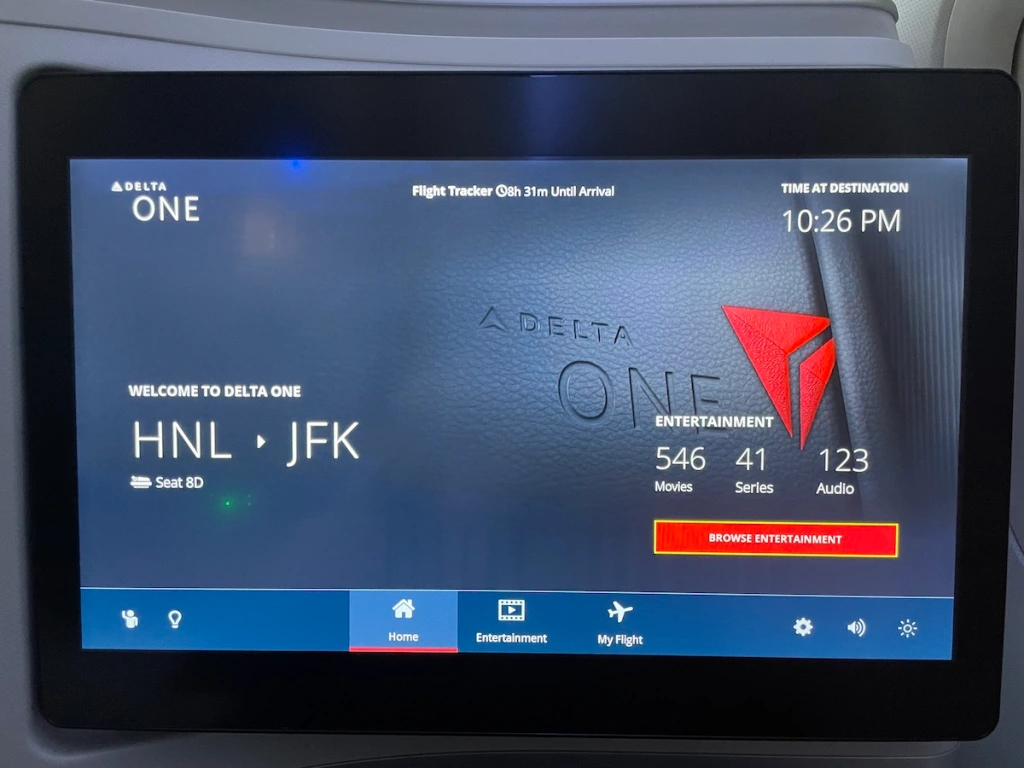

Should the thousands of hours of programming not be sufficient for you, you can connect to the internet. Delta excitedly announced in January 2023 that free internet would be rolling out to most of its fleet in February 2023, but alas, this does not yet apply to most Delta One-equipped aircraft – that functionality should be arriving before the end of 2024. In the meantime, you can purchase a pass on the 767-400 for around $40 per flight. That’s pretty expensive, but on my particular plane the satellite internet was inoperable, which is arguably an even worse fate (where you don’t even have the choice to spend that kind of money). Beyond that, there’s a comprehensive, better-than-average moving map that cycles through three-dimensional animations depicting the plane’s position, and most Delta One seats have two windows in case you’d rather just gaze out.
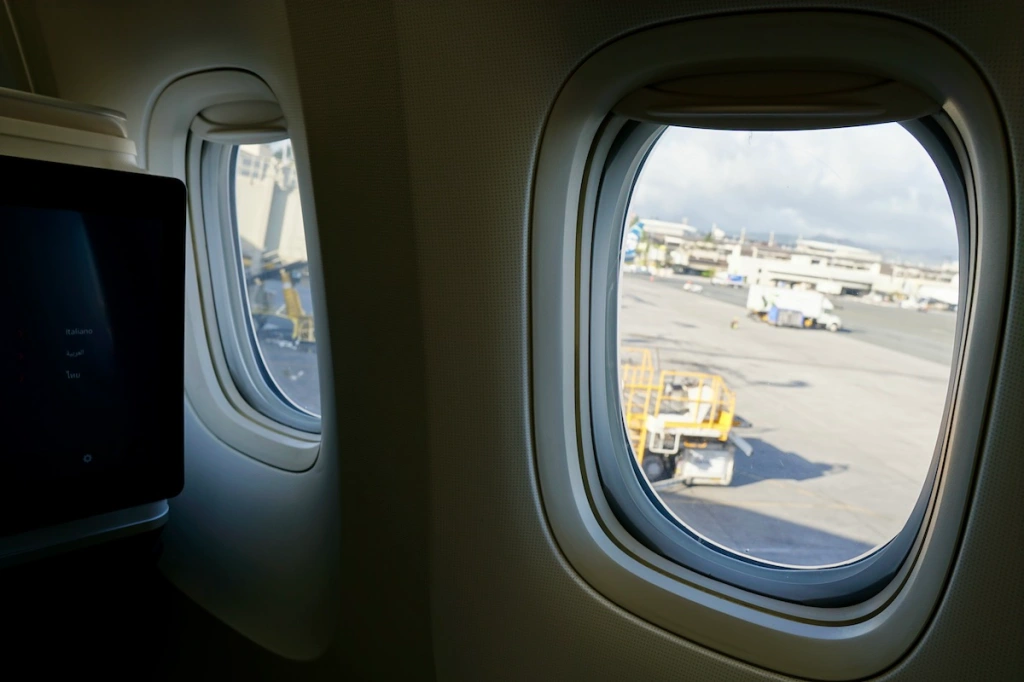
Delta made waves in 2016 when it announced that, instead of regular seats, it would begin outfitting its long-haul business class cabins with suites. The key difference is that the latter offers sliding doors, and at the time, no other carrier could match this outside of first class. For all the hullabaloo back then, it’s a bummer the innovative seat model is too wide for the relatively narrow 767 airframe, and so this iteration of Delta One comes without a door. Fortunately not much is lost in the grand scheme of things – some actually prefer it this way – and it’s not like you’ll be feeling exposed, anyway. This is especially true if you’re positioned away from the aisle in a “true window.”
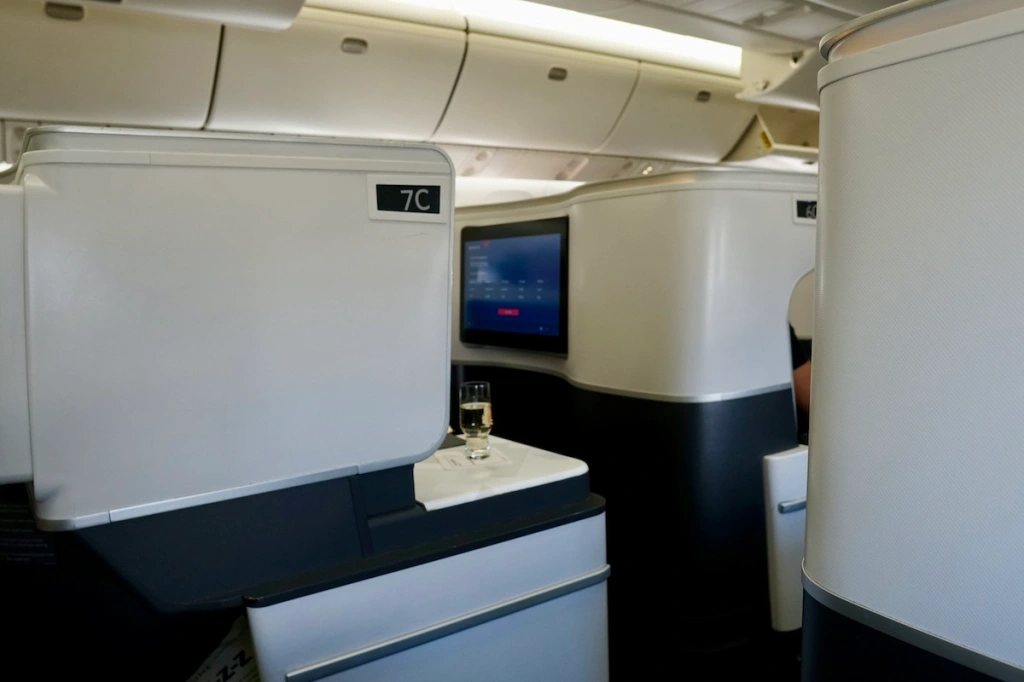
Shortly after boarding, the flight attendant responsible for my aisle, Lisa, appeared with a tray of predeparture beverages. She offered a choice of water, sparkling wine, and a Hawaiian classic, POG juice (i.e. passionfruit, orange, and guava juice), all of which came in proper-but-strangely-shaped glassware.
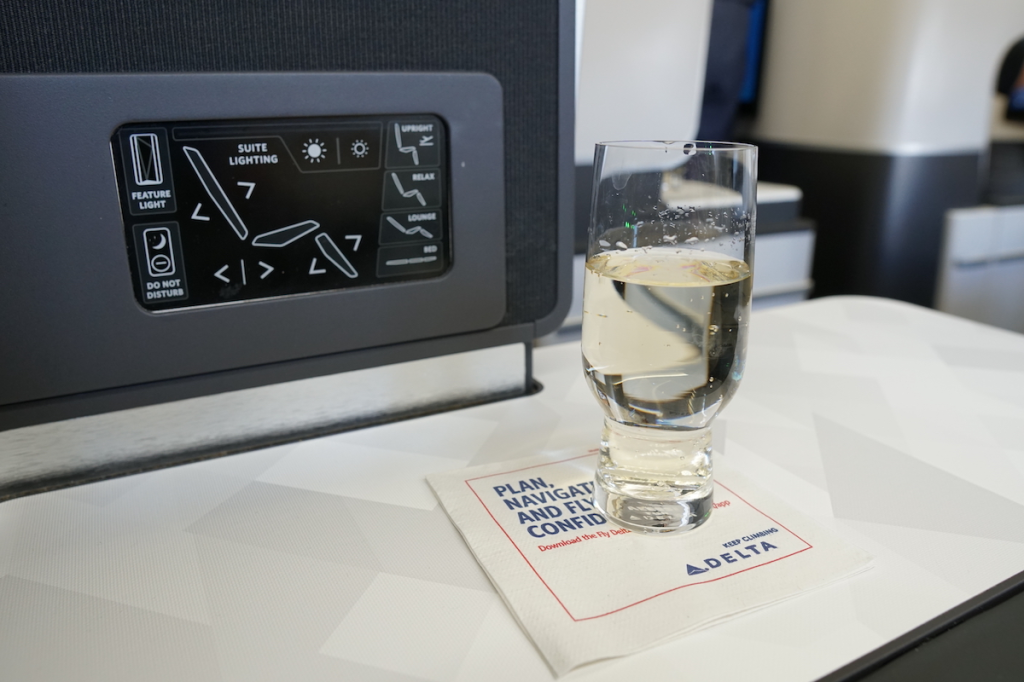
The purser, Sondra, meanwhile introduced herself and the other crewmembers working the Delta One cabin. Notably, she took the time to address everyone by their formal names, ask their preferred names, and then relay the answers to her colleagues. So, after first being addressed as Mr. Colins by Sondra – who, for what it’s worth, thanked me for being a Platinum Medallion member – both Sondra, Lisa, and others subsequently addressed me as Paul. I have never before seen such impressive attention to detail in business class. Sondra also distributed dinner menus while making the rounds, and these too reflect Delta’s newfound commitment to sustainability. Instead of handing out multipage single-use booklets, she merely presented passengers with a list of entrees and a QR code printed on recycled cardstock.
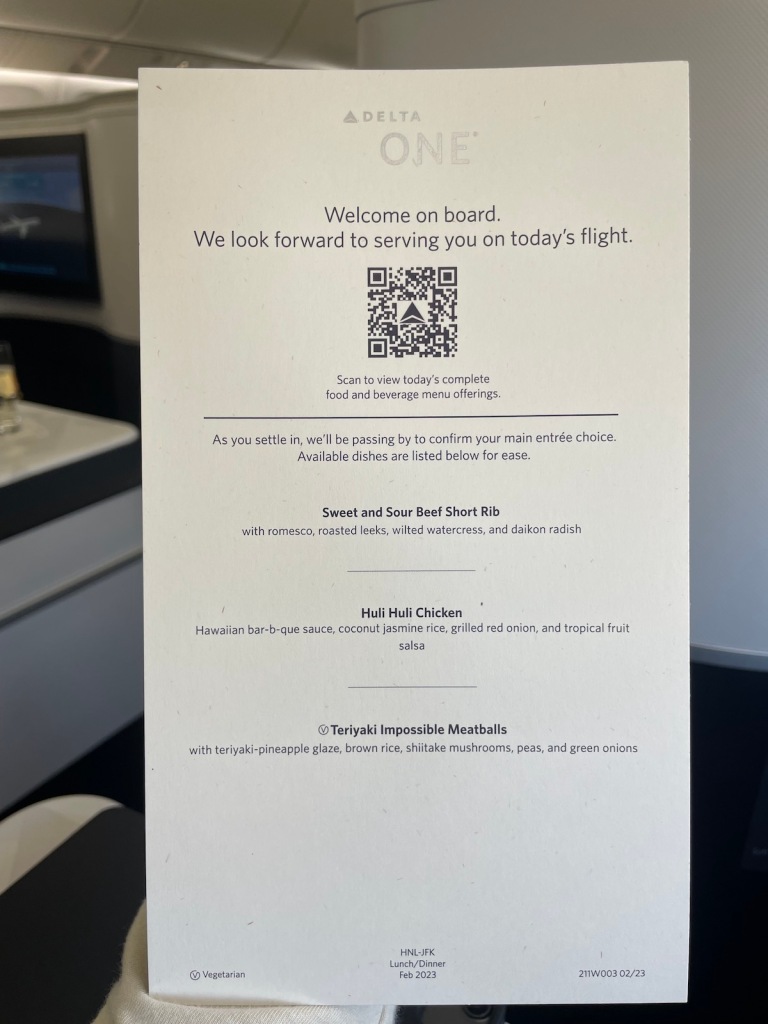
Details about appetizers, sides, desserts, and drinks are published digitally now (present tense because at the time of this writing, you can still scan the code if you’re so inclined to see what’s available on DL 305), which makes for a minor-but-understandable change.
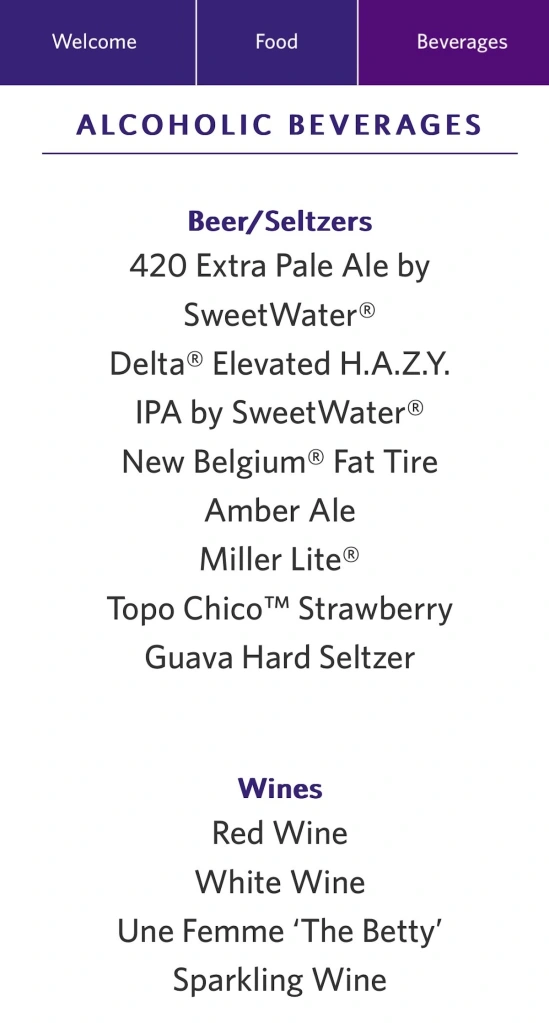
Other onboard goodies include a noise-cancelling headphones resembling Bose QC25s – they’re decent-enough but don’t sound as good or feel as comfy as a genuine Bose headset – a pair of slippers, should you want to move around the cabin sans shoes (for your own good, please don’t go barefoot), and an amenity kit.
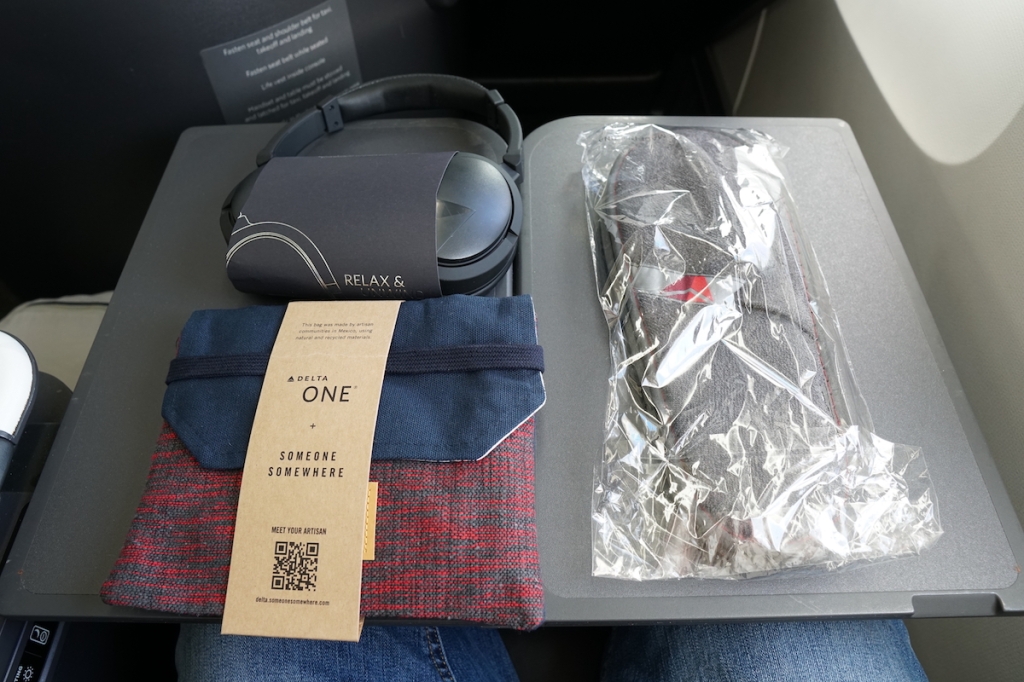
The amenity kit, which is produced by Mexican artisans under the Someone Somewhere brand and furthers Delta’s sustainability efforts (and also support typically-exploited laborers), replaces a beloved Tumi-designed predecessor. While the new pouch may not be as distinctly-styled as the previous hard-shelled one (nor likely as expensive, too), it’s perfectly sufficient, providing passengers with a few toiletries, an eyemask, a bamboo toothbrush, and a cardboard pen.
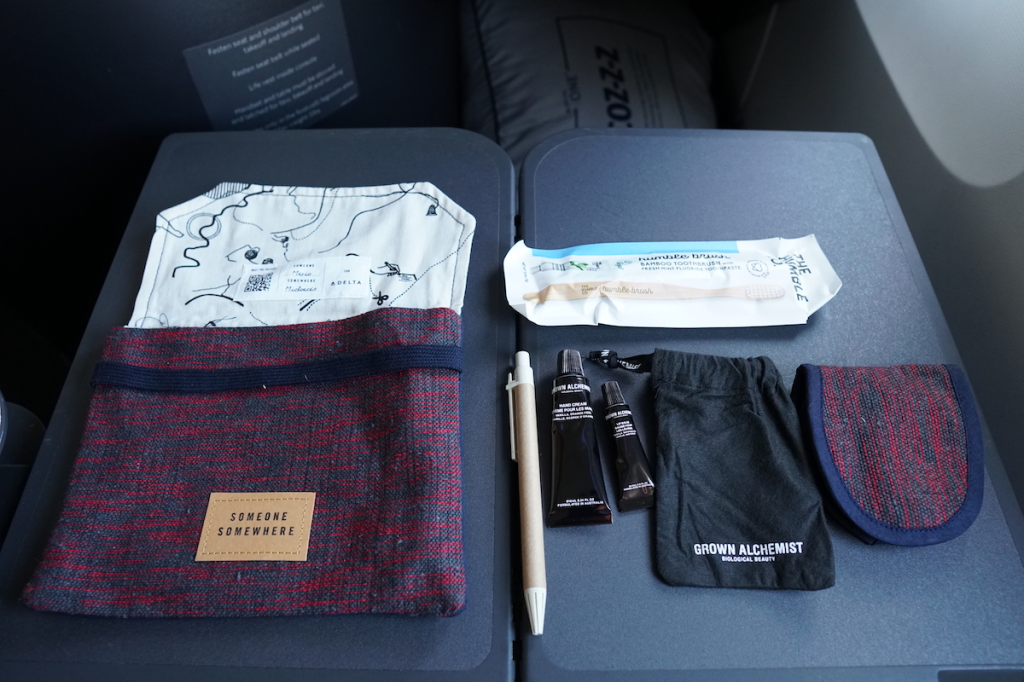
United stands alone with its remarkably varied bedding options, but Delta’s single pillow is soft and plush, and the sheet is large enough to cocoon even the biggest bodies. Also, per the environmentally-friendly bag they come in, they’re both made from over 100 recycled plastic bottles.
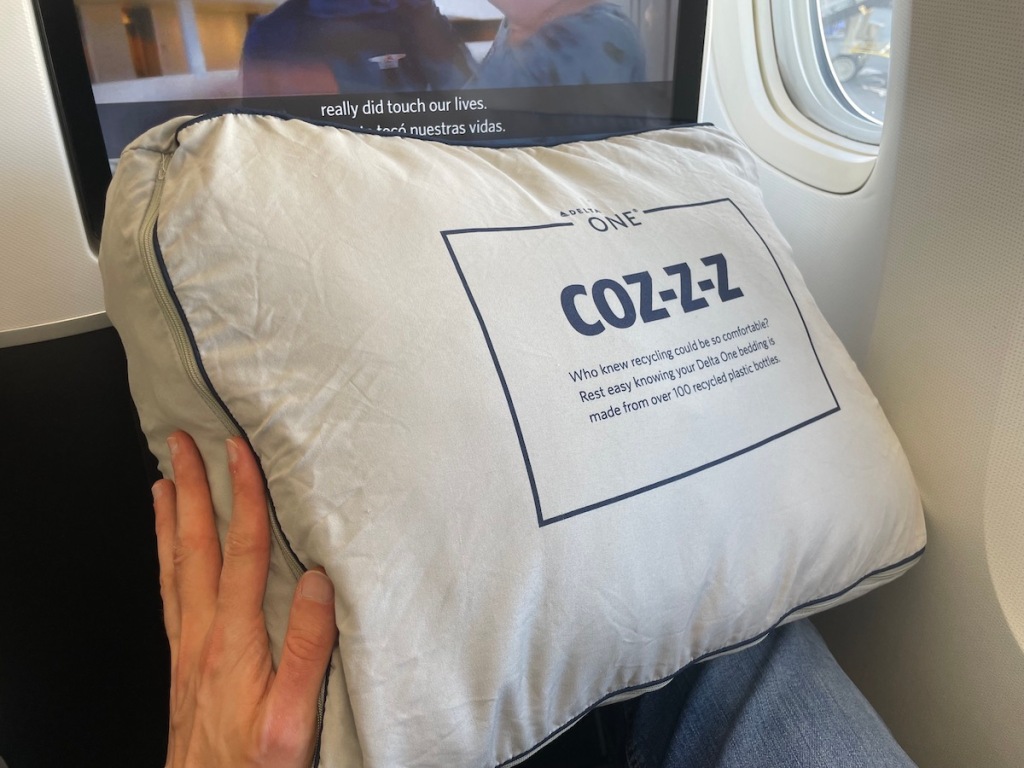
Anyway, the plane pushed back right on schedule at 4:55pm, and despite being held up on the taxiway for a few moments, Captain Mike assured passengers we would be in the air in no time. He kept his promise, with wheels up clocked a mere nine minutes later at 5:04pm, and off we went into a beautiful Hawaiian evening.
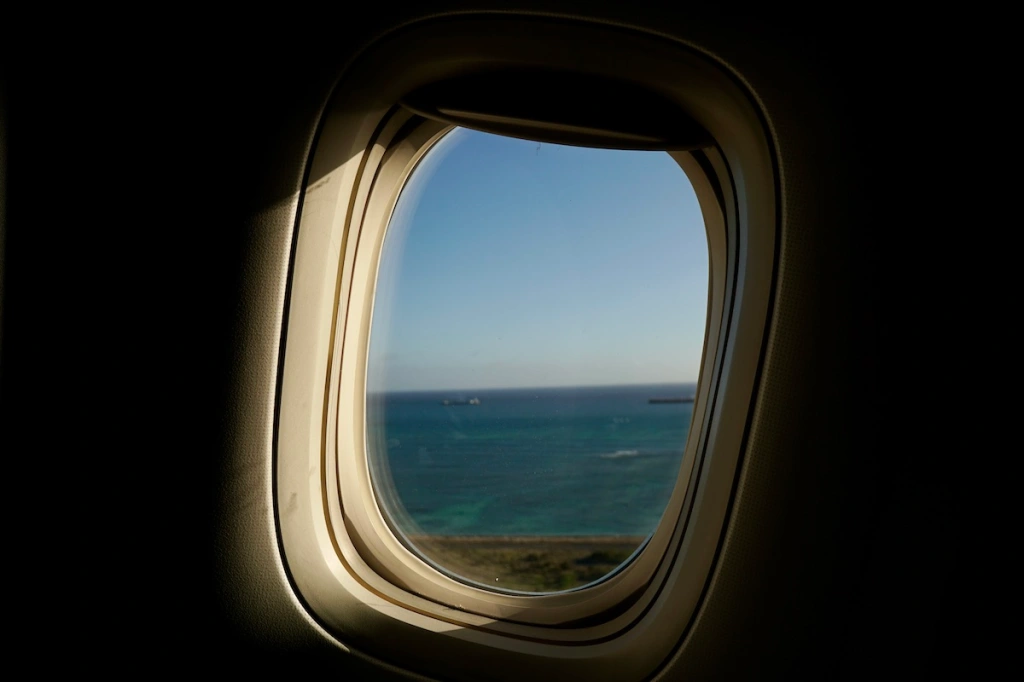
There was some rough, windy air throughout the first couple hours of the flight, but within the first 30 minutes airborne, Lisa was skillfully pushing and balancing a bar cart down the aisle. If for whatever reason the smartphone-enabled menu is finicky – or if you fancy a more engaging interaction – you can peruse the bottles and beverages available, and solicit some recommendations, too.
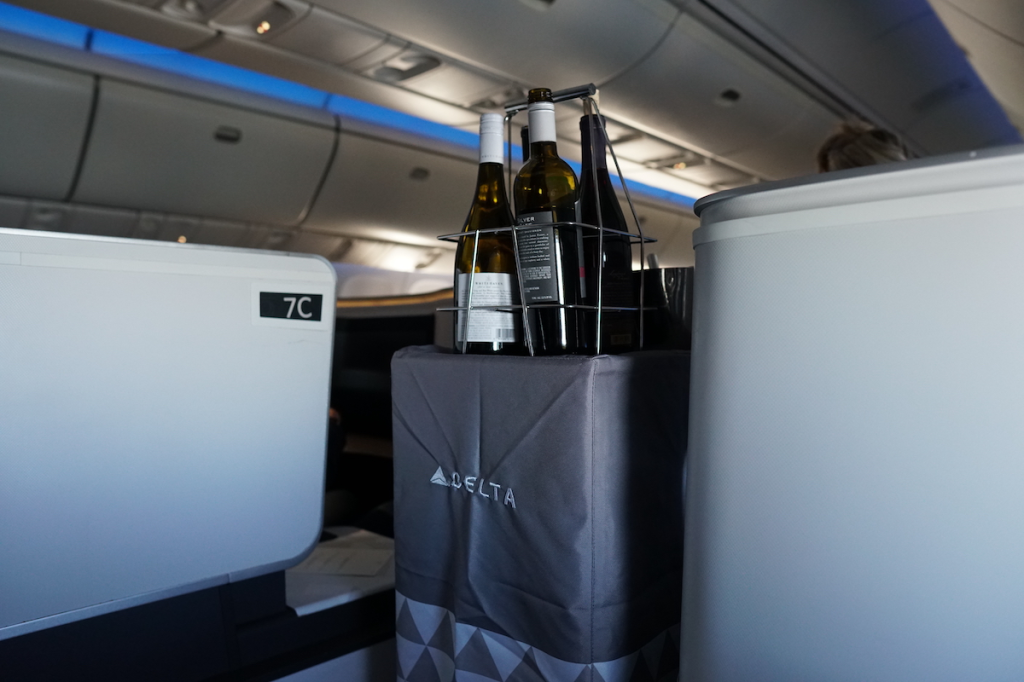
I opted for more sparkling wine and some still water – if you’re into brand-name waters, Delta stocks SmartWater in business class – and the glasses were served alongside a ramekin of candied nuts, savory cheese cubes, and salty olives.
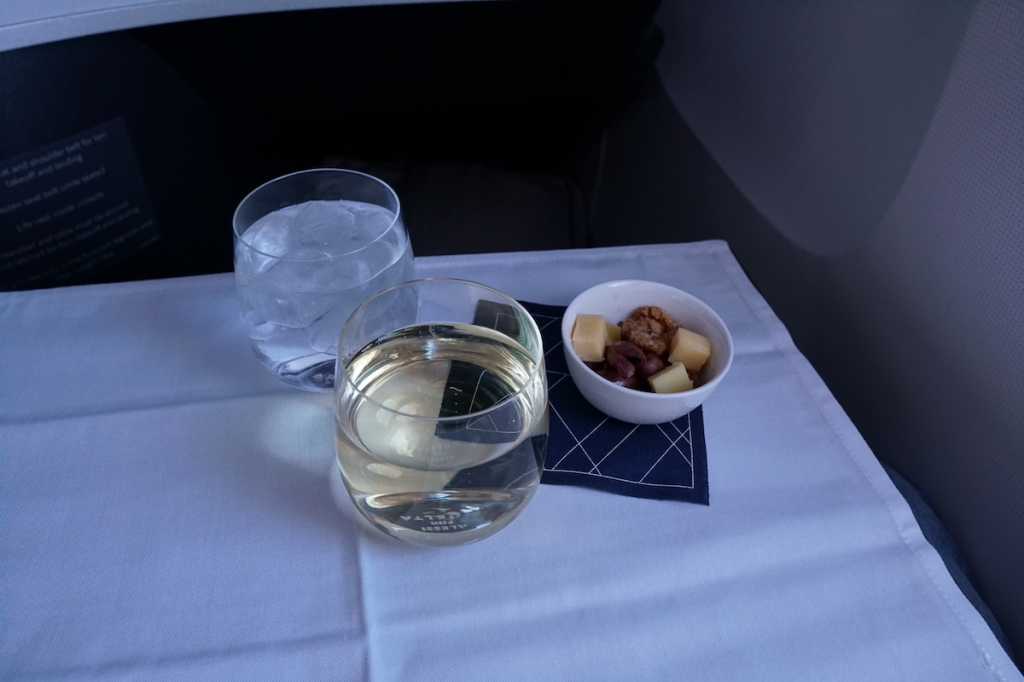

The happy “hour” only lasted for half that, and dinner was served on a single tray exactly 60 minutes after takeoff. Between the pineapple and burrata salad to start, the Hawaiian-styled barbecued chicken, rice, and tropical salsa bowl for an entree, and a purple Taro roll on the side, everything was memorably tasty.
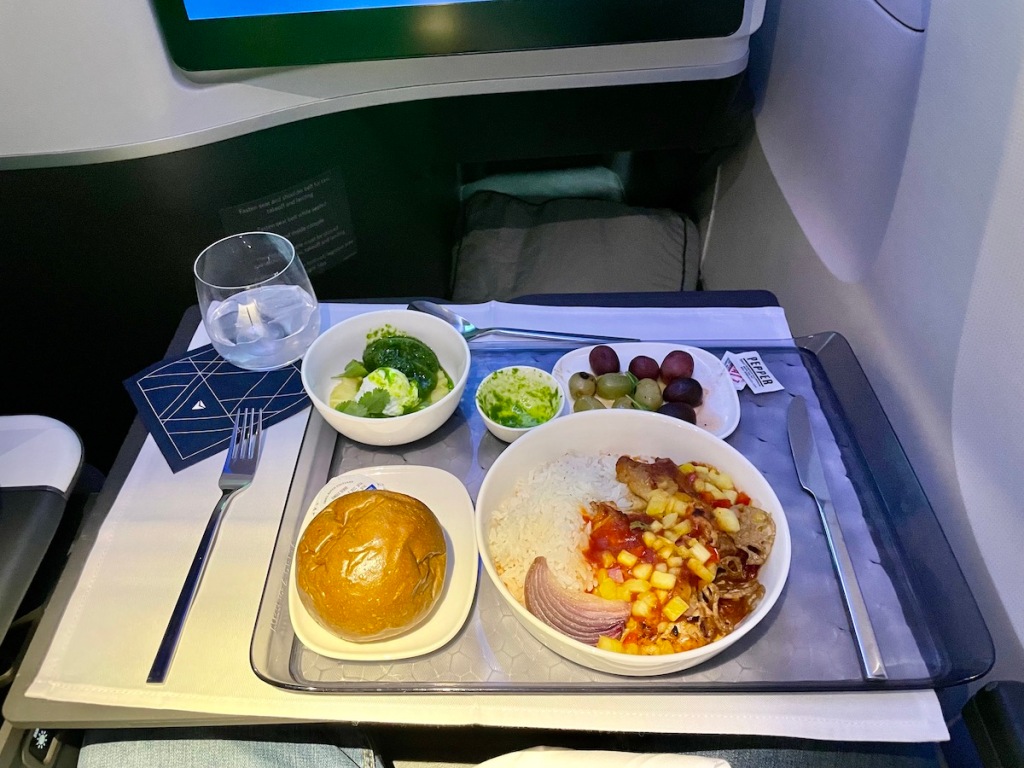
Catering meals for a plane and subsequently preparing them onboard can be a challenge. The chefs on the ground clearly incorporated local culinary traditions into their meals, and the crew exceeded expectations reheating and plating them.
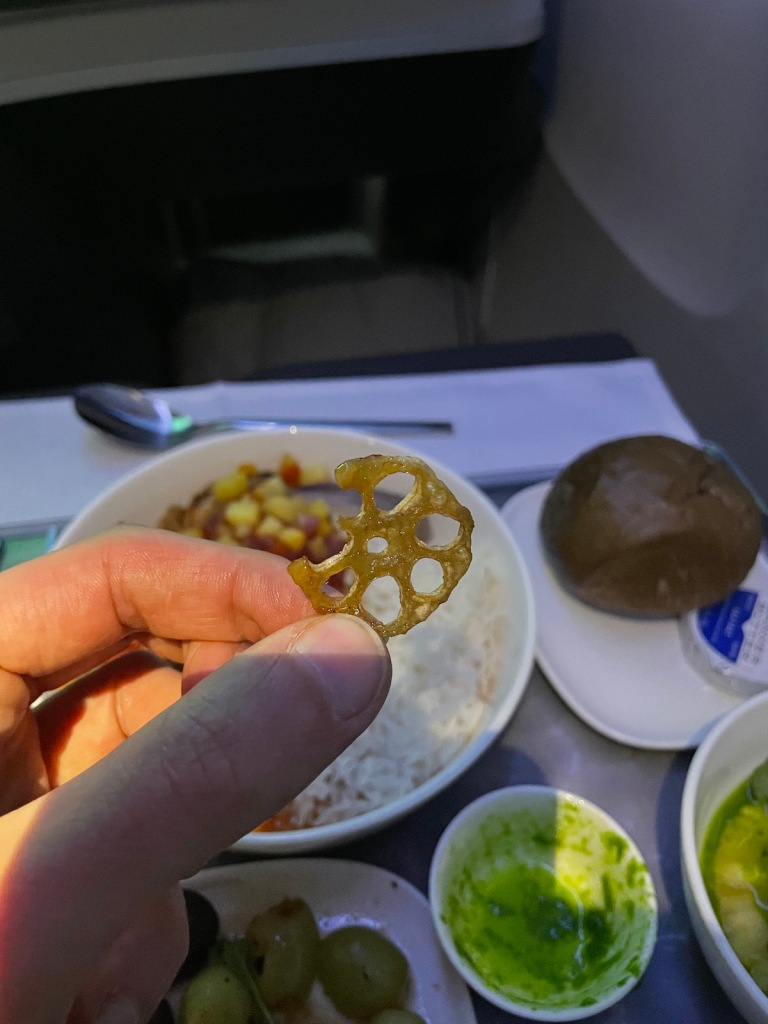
Beyond the delicious food, Lisa periodically appeared with refills. During one visit she proactively suggested pairing the chicken with Delta’s airplane-exclusive cobranded beer, the H.A.Z.Y. IPA. It was created by the Atlanta-based Sweet Water Brewing Company, and indeed, it was citrusy without being overpowering, and complemented the more-savory entree.
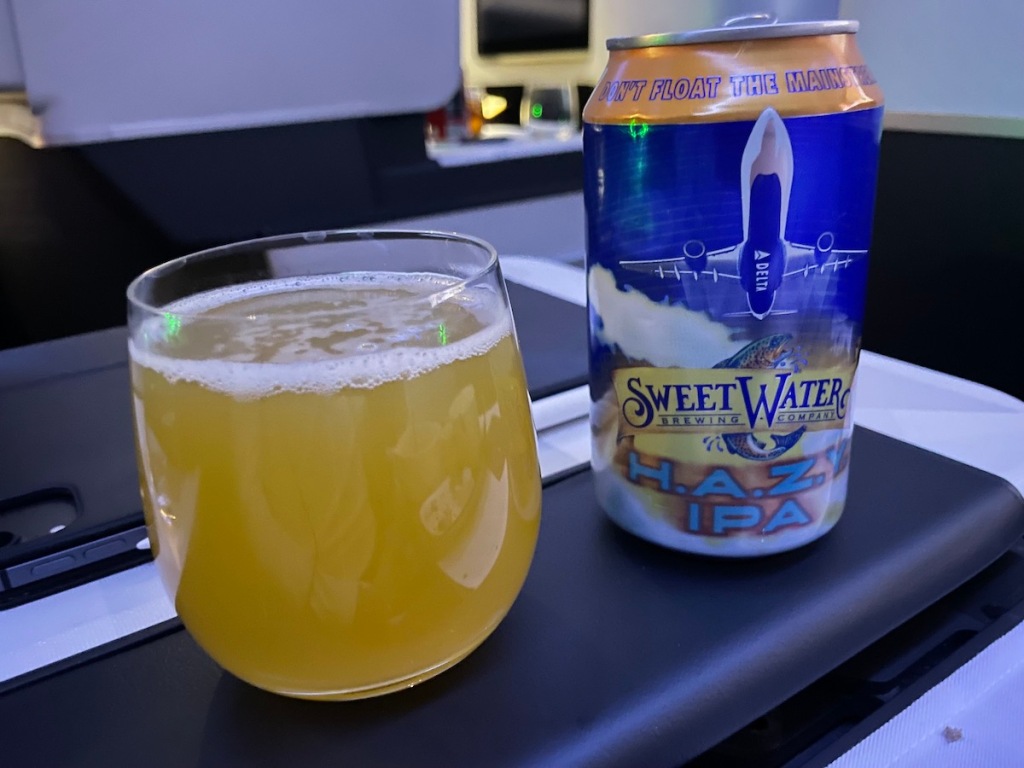
One thing sorely lacking from dinner was a more-substantive dessert option. I’m all for healthy eating and the grapes candied with cream, honey, and mint were more than enjoyable, but as American and United flyers can attest, it’s hard to beat an ice cream sundae at 38,000 feet.
Tray tables were cleared 45 minutes after they were set – a mere 90 minutes had elapsed since departing Honolulu – and the crew began prepping the cabin for bedtime by gradually dimming the moodlighting. Despite the obvious priority to get people asleep, nothing about dinner ever felt rushed or harried; it was an exceptionally-well executed service, and as a result, we would be able to get full nights of sleep.
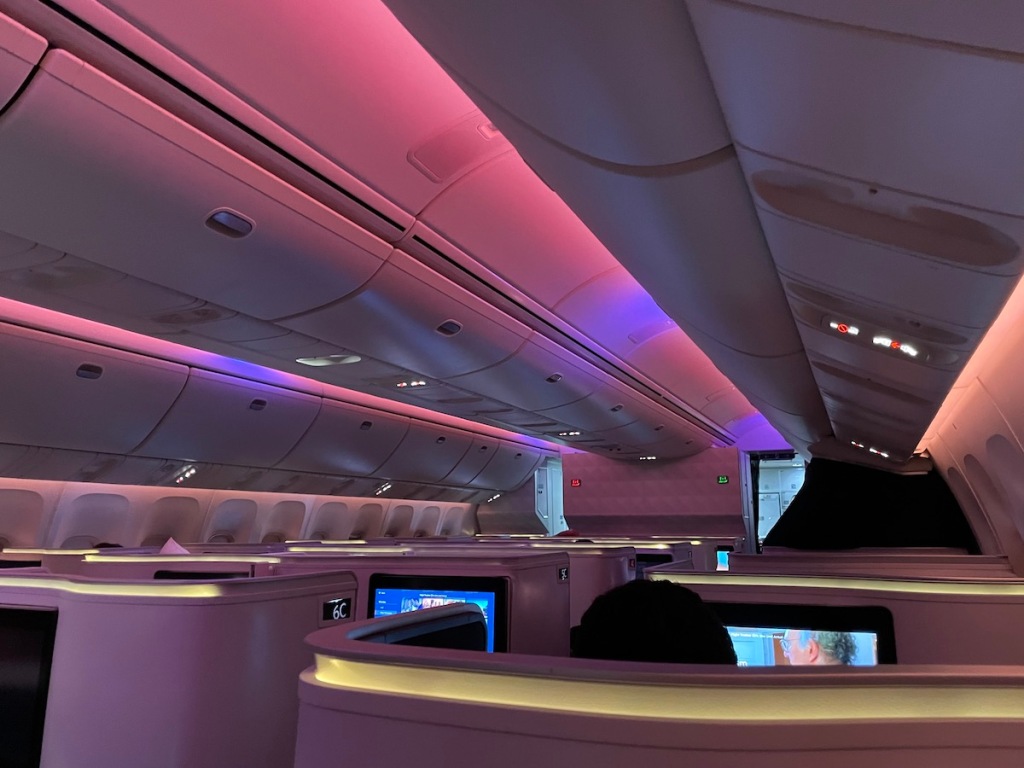
There are two lavatories for the 33 Delta One passengers and the pilots to share, and while that’s not a great ratio, they only got egregiously busy right before landing. Crucially, they were kept in reasonably good shape throughout the flight.
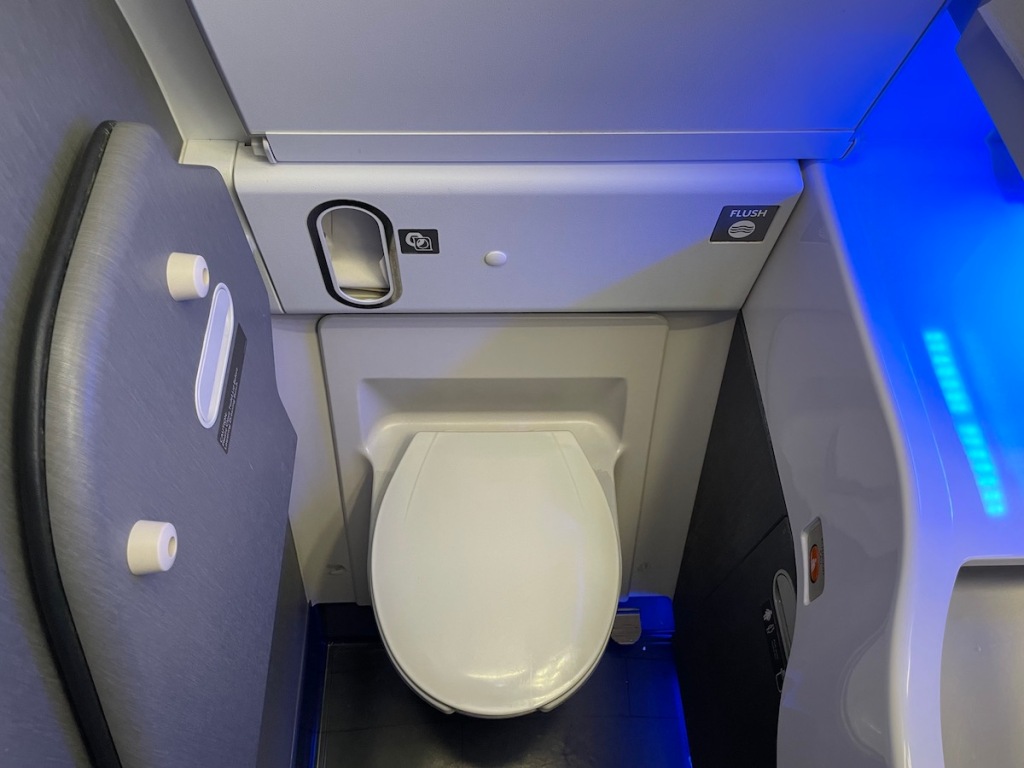

There are bottles of “luxury” soap and hand cream available by the sink, both of which are are supplied by the Grown Alchemist brand (vice Malin + Goetz), and are perfectly acceptable for what they are.
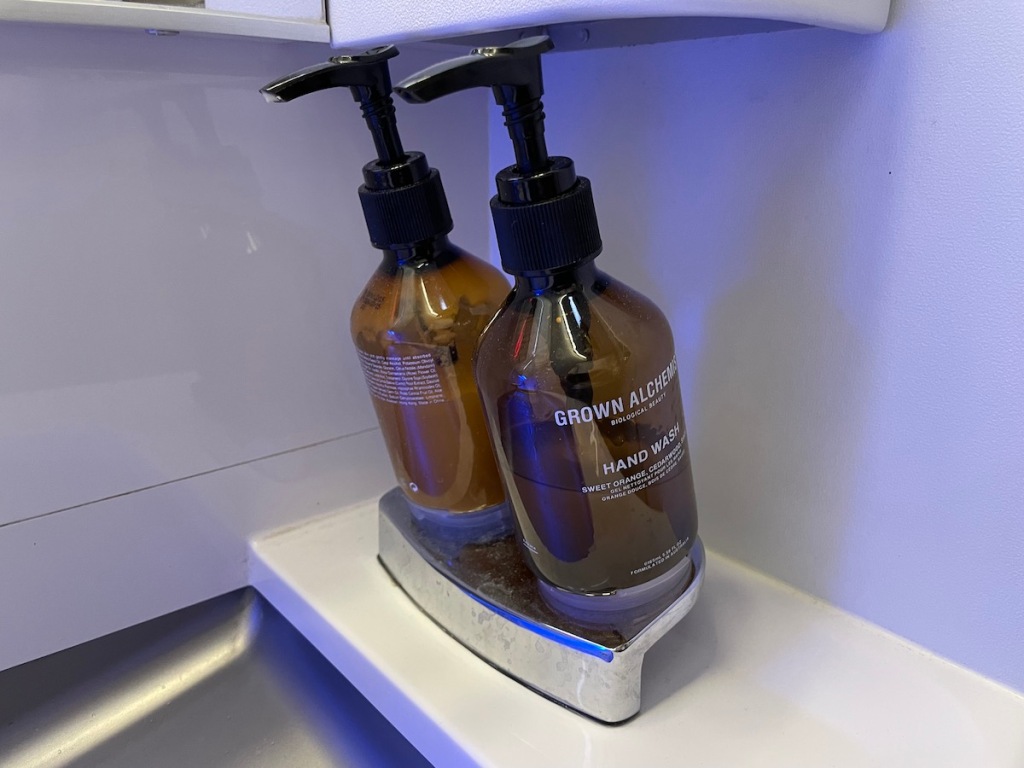
There’s a fold-out padded bench that can make getting changed in or out of sleep clothes much easier. It’s a smart feature that prevents higher flyers from having to hop around a germy toilet when putting on pants and simultaneously trying to keep their feet from touching the floor.
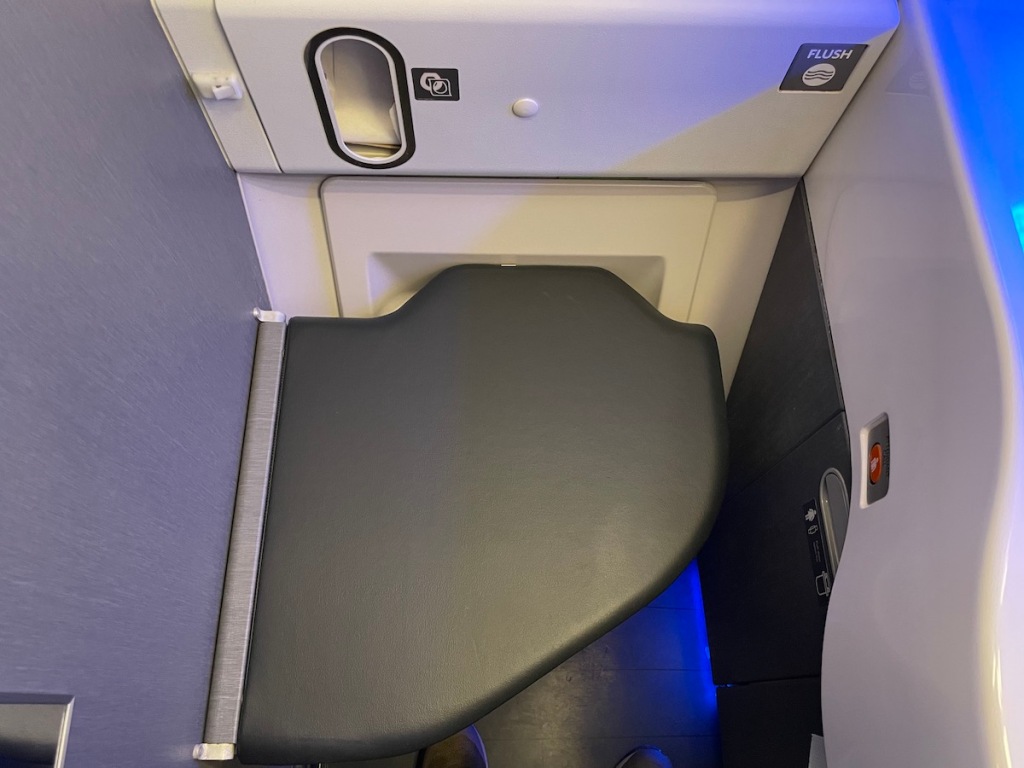
No matter how hard the airline tries to market it, or whether or not it comes with a door, a Delta One “suite” (as they call it) will never be mistaken for a bedroom. It’s much more of a tricked-out cubicle than a sumptuous luxury hotel – although you can activate a “Do Not Disturb” placard to discourage flight attendants from waking you up – but like so much everything else, it’s fine for what it is, and is competitive compared to other options in the sky.
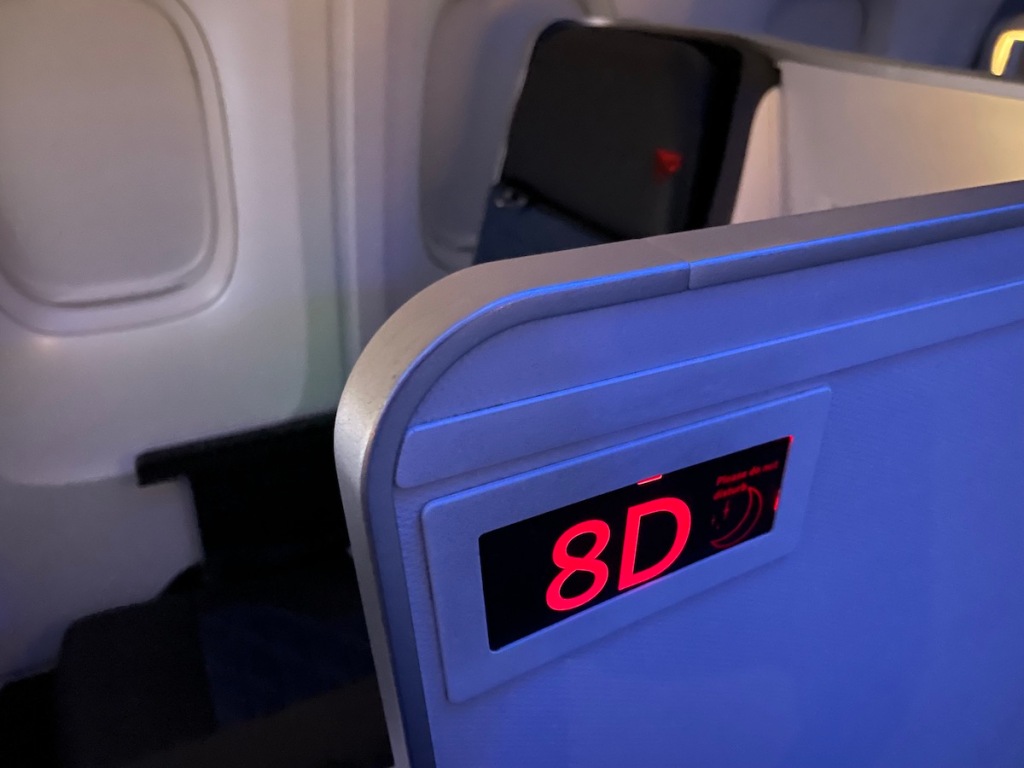
These “suites” nevertheless are appealing places to spend the night, and they certainly beat the onboard alternatives. Moreover, having access to something resembling what you might get on terra firma can be an immense help in fighting jetlag, and also preparing yourself for the reality awaiting upon landing.
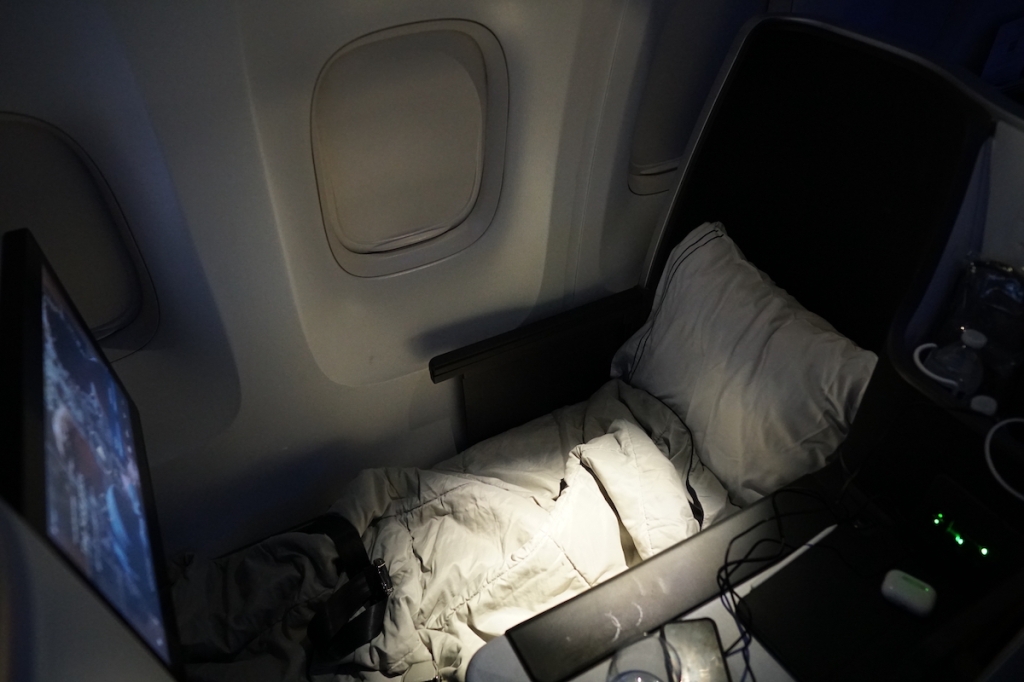
When fully reclined, the seat is about as spacious/cozy as a sleeping bag, but you’ll enjoy much better padding than you would if you were on the ground. As a 6′ 3″ (190 cm) side sleeper, the surface area was long enough so I could fully stretch out, there was enough room in the middle section to comfortably bend my knees, but the shoulder space was slightly too cramped. Some have likened Delta One on 767s to sleeping in a coffin – that characterization seems a bit extreme – but I did wake up twice with arms asleep.
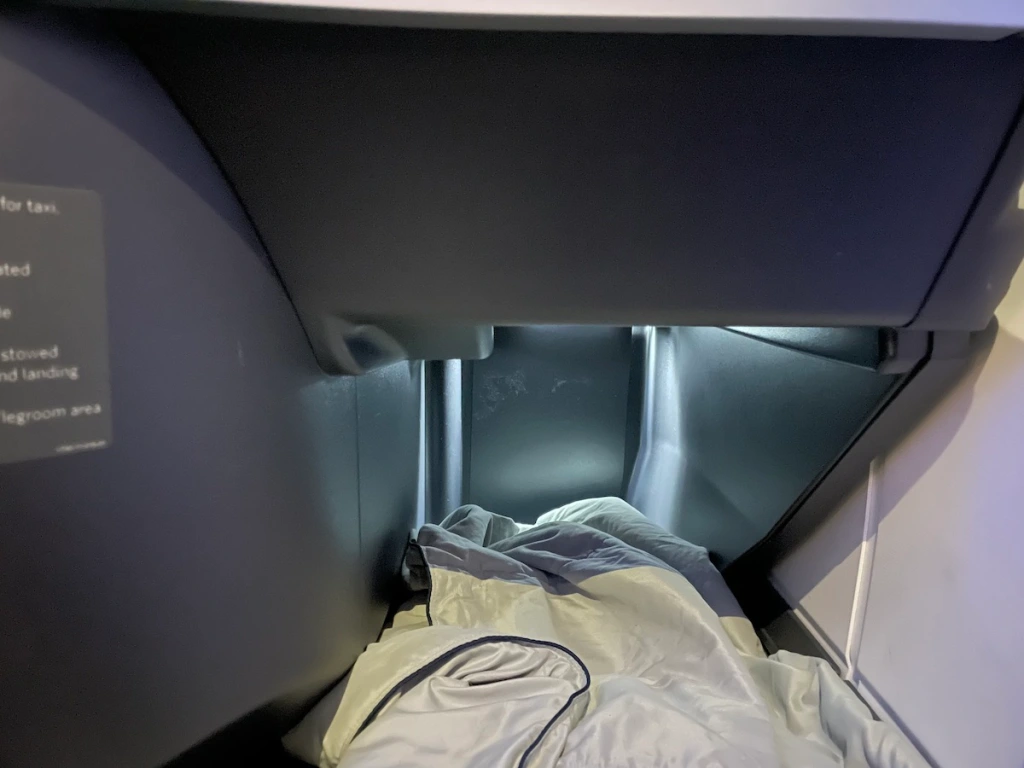

Because of the efficient dinner service, I tucked into bed two hours after takeoff with seven hours left to go to New York’s JFK airport. Lisa appeared with a bottle of water and earplugs before I turned off the light, which was a professional-yet-kind touch. It seemingly defies conventional wisdom, but especially in order to maximize sleep, longer redeye flights are usually preferential to shorter ones.
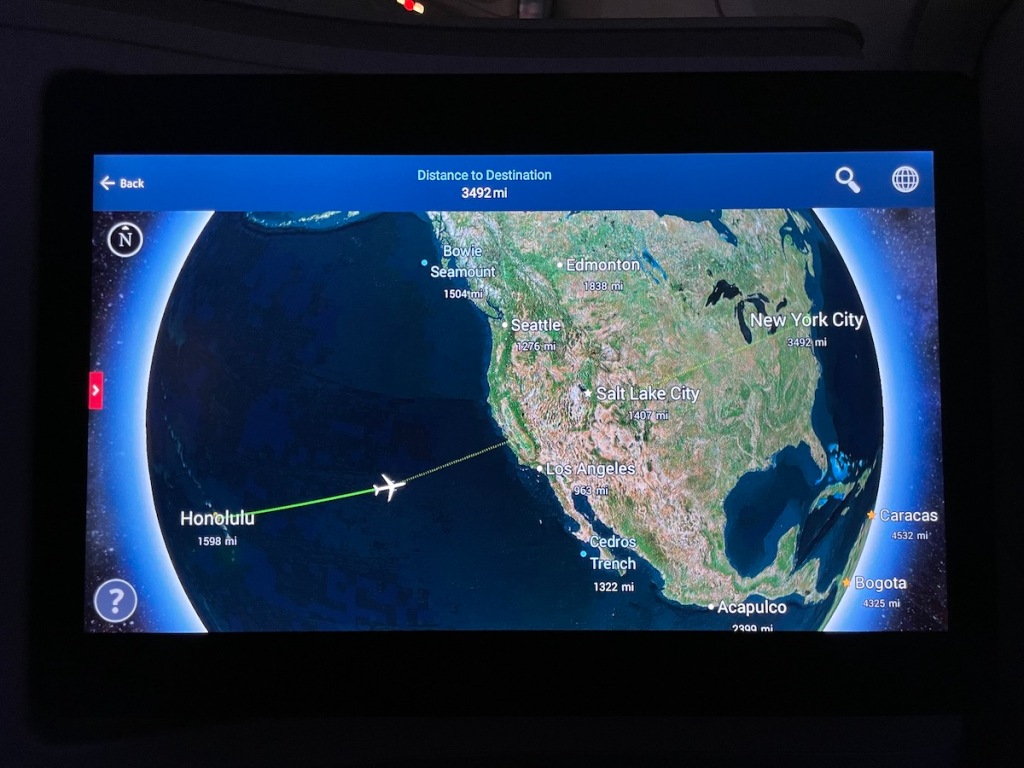
Aside from some mild turbulence in both the air and in the blood flow to my arms (as previously mentioned), I slept uninterrupted for nearly seven hours – arguably the height of luxury during long-haul travel – until Lisa came by with a cup of coffee and a chipper request to get up and get ready for landing.
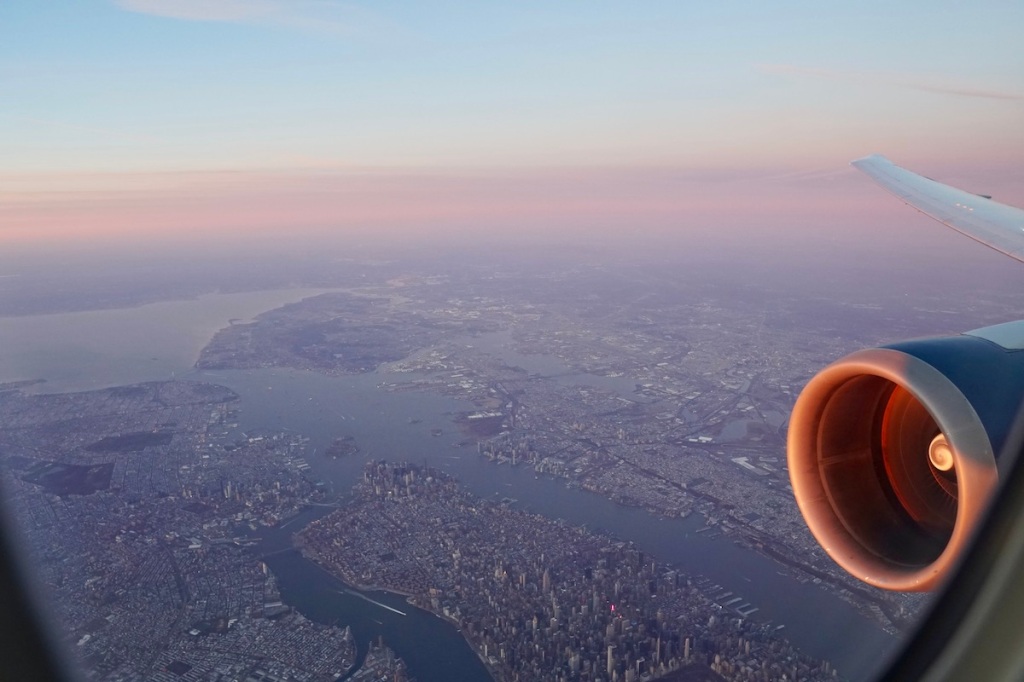
Breakfast comprising french toast OR coconut chia pudding was served to those who were awake at the time, but I was not and the flight attendants honored my “Do Not Disturb” request. Once everyone had woken up and the plane was on final approach though, Sondra passed chocolates around the cabin, and thanked everyone individually for flying Delta One. Talk about a sweet ending!
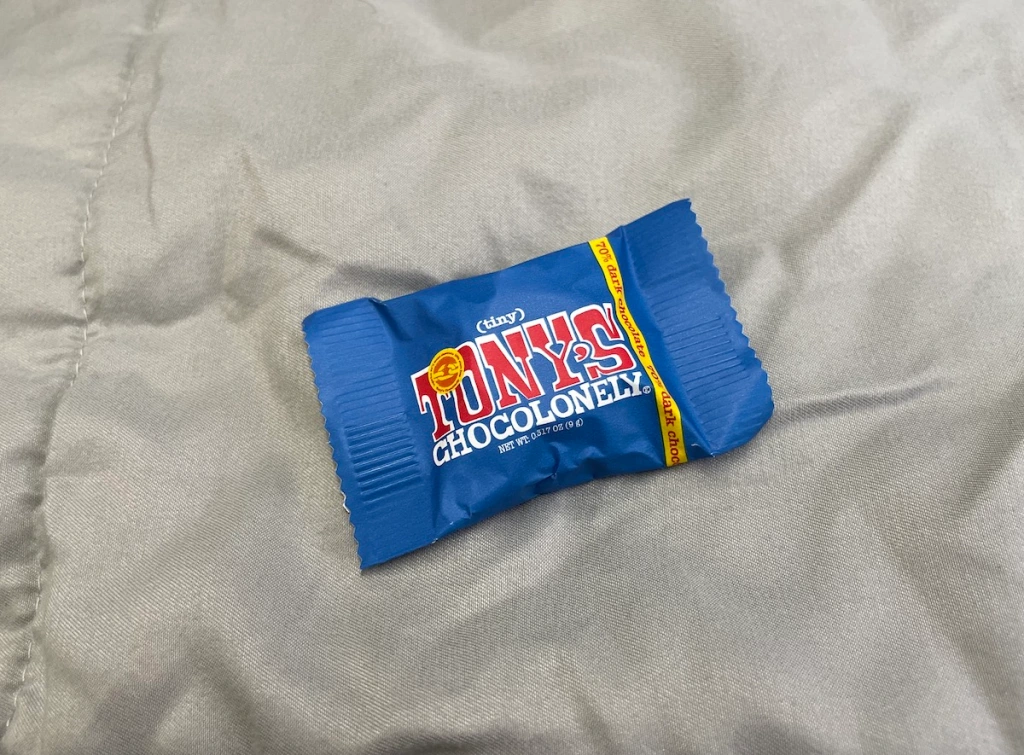
We touched down smoothly at 7:06am, exactly nine hours and two minutes after wheels up, and pulled into our gate 15 minutes before our scheduled arrival time.
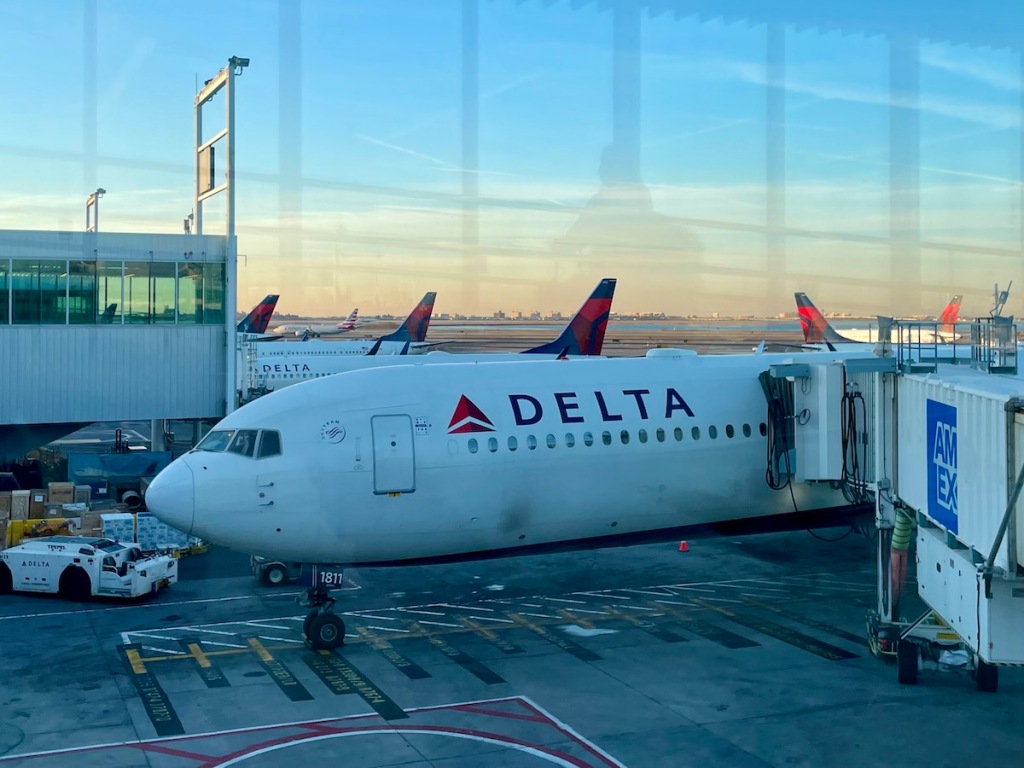
Aside from expedited handling at the baggage claim, there’s one last meaningful perk for Delta One passengers: you’re able to access the SkyClub on arrival. Assuming you’re able to remain in the airside part of the terminal – sorry to those coming from overseas who must clear immigration and customs and then leave the airport – you can wake up on the redeye flight, head to the lounge, and then check-in to a shower to freshen up.
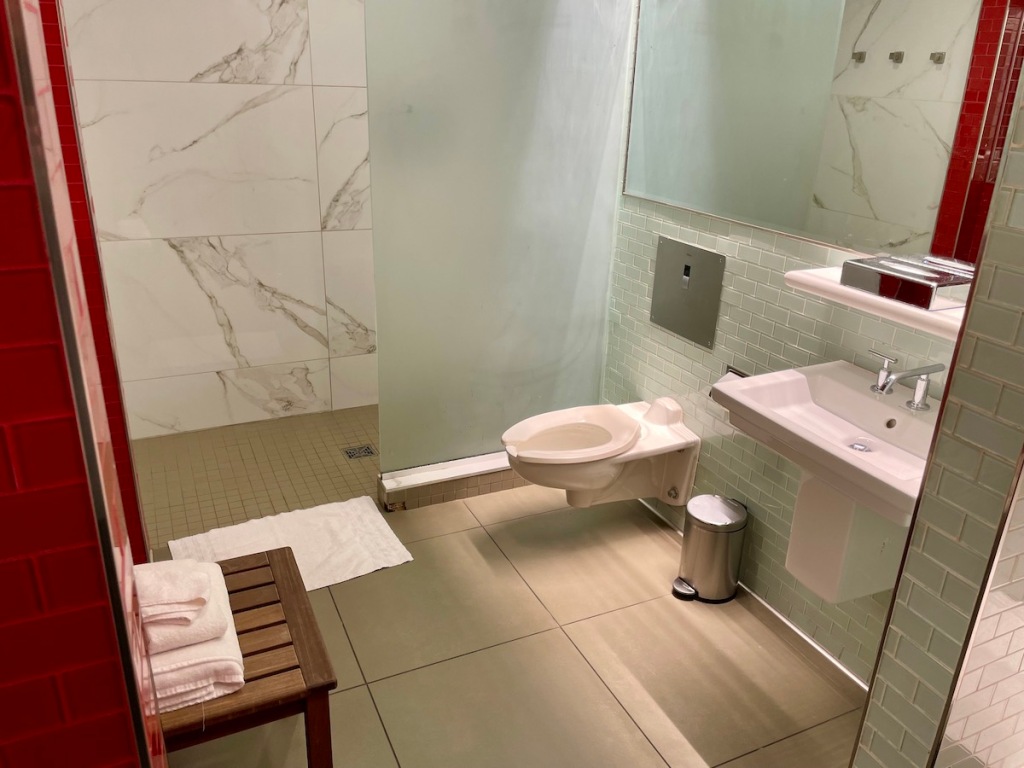
Washing away the cobwebs after a full night’s sleep put the finishing touches on my rejuvenating trip from paradise. Going back to reality after a fun Hawaiian vacation is never fun, but Delta makes sure its premium customers are equipped to make the transition as happily as possible. Talk about higher flyer!
In terms of what you could want from long-haul business class, Delta One offers one of the more-complete experiences; this is especially true on domestic routes, where no other U.S. carrier can match Delta’s total value proposition. From start to finish and beyond, the airline delivers all of the accommodations you would need to feel comfortable every step of the way. While its hard product may not be visually striking like its foreign counterparts’ offerings, Delta’s Stormtrooper-chic suites are comfortable, practical, and largely accomplish what they need to do. The same characterizations could be applied to the food and the amenities – simply good – but the crewmembers warrant special recognition. Delta has a strong reputation for its kind and helpful service culture, and on this trip, the flight attendants reinforced the reasons why. Any weaknesses are relatively trivial compared to the product’s strength and competition, so if you can book a flight like this one at such reasonable rates, it’s a no-brainer EVEN IF you have loyalty considerations.
The good, the bad, the ugly of Delta One on the 767-400
- The Good:
- Within the United States, Delta One checks more boxes than any other premium alternative; overall it’s the strongest business class offering in the country.
- Delta runs a consistent and reliable operation that’s now turning towards greater sustainability, and its employees on the ground and in the air are thoughtful and kind professionals.
- The newly-installed hard product onboard the 767-400s is appealing and, more importantly, comfortable for long-haul travel. Its designers catered to what passengers prioritize most without having to compromise too much.
- Dinner was especially tasty, and it included flavors unique to Hawaii.
- All of this can be yours at one of the lowest cash prices in the Hawaii-New York market sector!
- The Bad:
- For as attractive as the cash rates can be, Delta One SkyMiles redemptions are – even at their best – hideous.
- The Ugly: Many of these are personal preferences, but still…
- The bed was a little bit too narrow. Likening the seat to a coffin is a bit over-the-top, but you can see where the critics are coming from.
- While the single tray meal service was efficient, it wasn’t particularly substantive. Ice cream would have been a nice dessert option.
- It was hard to escape the feeling of whether or not elements of the experience – particularly the soft product – are actually good, or merely just “enough.”
- Delta’s desire to be more sustainable is admirable – especially in an industry notorious for its carbon footprint – but how much of the change is motivated by financial incentives? Color me cynical.
Have you flown Delta One before, either on the 767 or another long-haul plane? What are your thoughts?
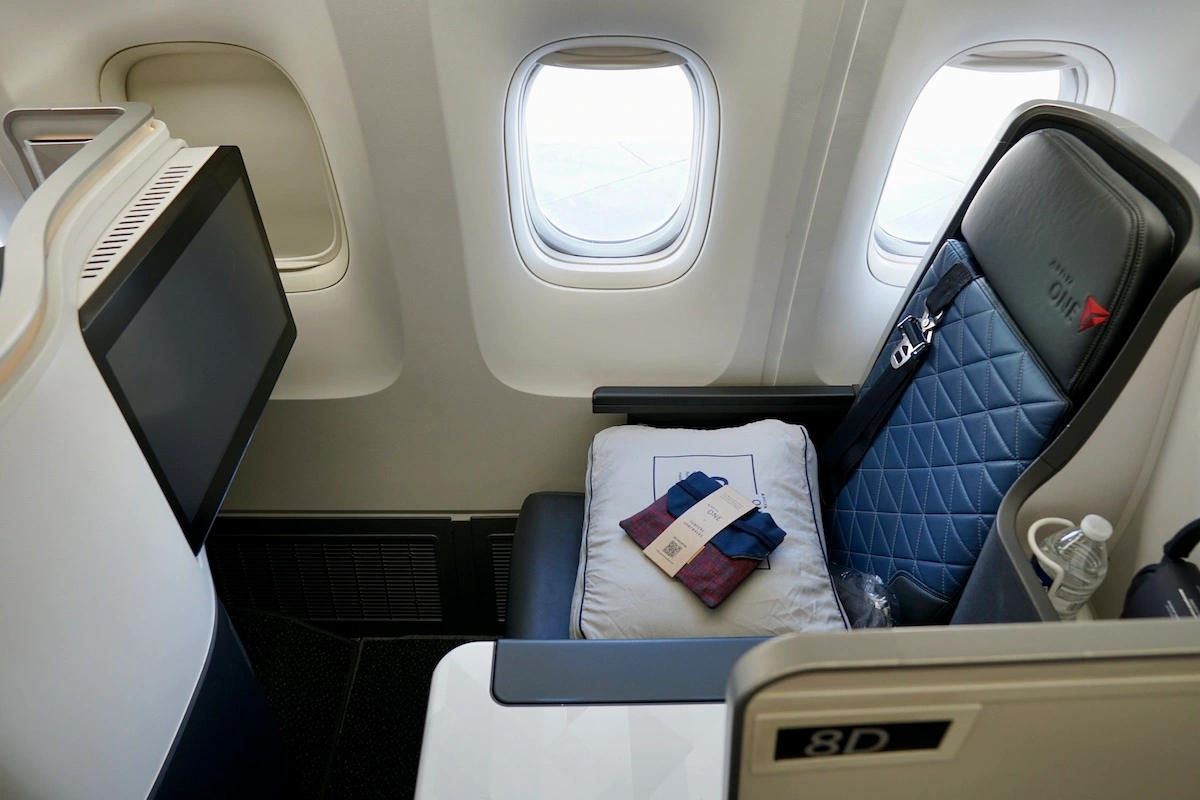
Leave a comment